 |
Charmouth - Scenes from its Past |
 |
|
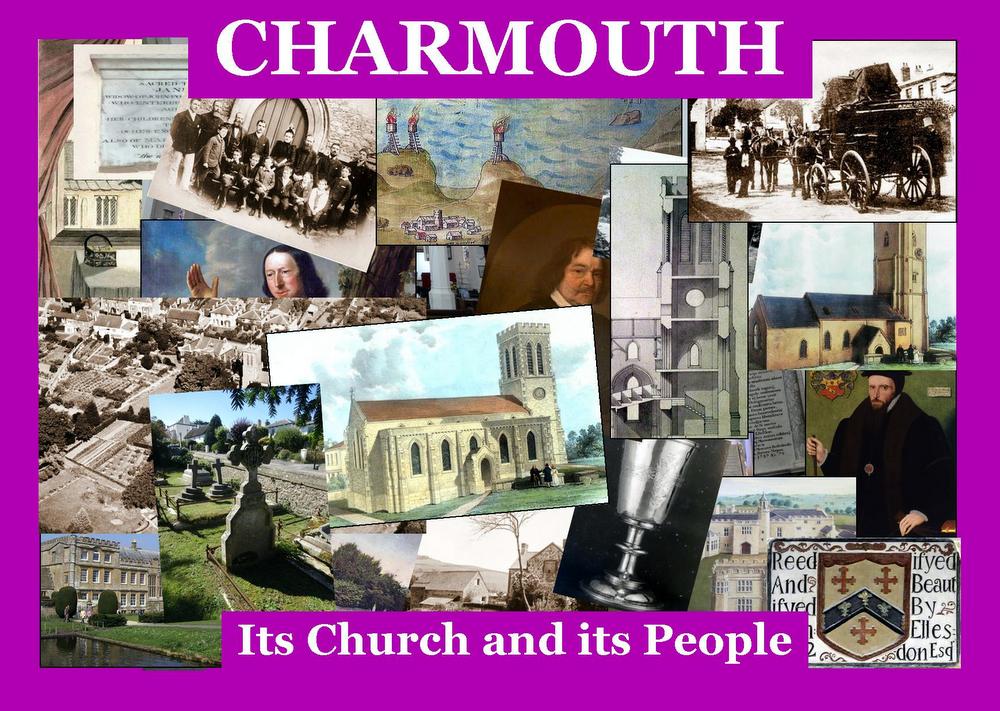 |
| This is the original Talk that we gave before the Book - Charmouth - Its Church and its People was published as a way of raising money towards the restoration of St. Andrews Church. Click on PDF for a copy of the book. |
 |
| If we could go back almost 2000 years we would have found a small settlement on a site which today would be further out from the Heritage Centre. The River was close by, but whose width and course would have been different to what we see today. |
 |
| Nearby would be the Roman Road that linked Dorchester with Exeter. Although there are no signs of this today a section was found recently at Hogchester Farm and an extensive Villa existed at Holcombe in Uplyme.
|
 |
| This Map shows the route of this road which was called the Ackling Dyke. The known sections are coloured in green and those that are red have still to be discovered. It is interesting to see the course of the famous Fosse Way that passed nearby at Axminster and linked the port at Seaton with that at Lincoln.
|
 |
| The Romans bought Salt Panning and no doubt many of the villagers at that time would have been involved. They chopped trees down in the abundant surrounding woods and burnt the timber under large lead basins which would be filled with sea water as shown above. The water evaporated and the layer of salt that was produced could then be used as a preservative, long before refrigeration. This was to be a major trade along the Dorset coast. Indeed the earliest document relating to Lyme Regis is in 774AD when Cynewulf, the West Saxon King granted land on the west bank of the River Lym to Sherbourne Abbey in order that Salt may be boiled there.
|
 |
| The prosperity of Charmouth for many centuries was based on Salt. The Domesday Book for 1086 shows the population included 16 Salt workers. In the same year, Lyme Regis had 27 workers. The main use of the salt was to preserve food for the winter months and was one of the first traded products which was carried along the existing Roman road by packhorses.
|
 |
As the settlement grew, a small chapel was built to serve it. The earliest record referring to it is a Charter at Salisbury Cathedral, dated 1240, which mentions the Chapel of Charmouth. when there is a dispute between William Heiron , Lord of Charmouth and the Parson of Church of St. Wite and Holy Cross (now Whitchurch Canonicorum).
The Hundred of Whitchurch was one of a number created by King Alfred the Great in the 9th century and covered a large area including Burstcock, Catherston, Colway in Lyme Regis, Pillesdon, Stockland, Symondsbury, Chideock, Marshwood and Stanton St. Gabriel. They were centred on the Mother Church which lies in the Vale of Marshwood, nearly three miles N.E. of Charmouth. and most of these villages had “ Chapels of Ease ”, some of which have survived.
|
 |
| This was the case in Charmouth, and the remains of the nearby Chapel at Stanton St. Gabriel's can give you an idea today of how this earlier building may have looked before it disappeared under the sea.
|
 |
| Services are still occasionally held here and this a photograph taken recently and gives an idea of the size of a similar Chapel in Charmouth which had stood nearer the beach in earlier times.
|
 |
| Another Chapel of Ease is even nearer at Wootton Fitzpaine.
|
 |
| Although much altered this plan shows the earlier 13th century walls still exist of the small chapel incorporated in the Nave of the building we see today.
|
 |
| In 1281 There was a notification by Robert Wickhampton, Bishop of Salisbury, that he had been informed by many trustworthy men that the chapel of Charmouth, built a long time ago near the sea, has been ruined by the battering of the sea and storms. He gave his authority and assent to the Abbot and monks of Forde, the patrons of the chapel, to move it to a more suitable site than the shore and build a chapel on their own land to the honour of the blessed apostle Matthew and All Saints.This they carried out in the year 1300 with the formation of the new borough of Charmouth
|
 |
No single owner of Charmouth had more impact on its history than Forde Abbey whose Abbots were to be it's Lords for nearly 400 years. Their Abbey had been founded in 1147 and in time was to become one of the richest and most learned institutions in England. By the end of the 13th Century they owned over 30,000 acres of land in Devon, Dorset and Somerset. It seems that land would be given to them on the understanding that they prayed for the souls of the donor.
Amongst these bequests was one in 1170 by Richard del Estre for land in Cernia as Charmouth was known then. Later his son confirmed this gift with another adjoining piece of land given by his brother Ace. With additional blocks of land the Abbey was soon the owner of the village and the Abbot was being described as Lord of the Manor in later documents.
The monk's established a Grange here which would have been worked by lay brothers. There was also a Guildhall, Mill, Market Cross, Pillory, Fair and Bridge.
|
 |
| All this information and much more can be gleaned from a book still in existence and held at Forde Abbey known as "The Cartulary", which has over 60 entries for the village detailing land transactions, which gives a picture of the village in those times. But the most important event in Charmouth's history took place between 1290 and 1297 when William, Abbot of Forde improved the Manor by making it a Free Borough. This was shortly after the destruction of the earlier church and the new one must have been carefully sited in the centre of the new Borough, by the cross roads of “ The Street ” and the tracks that led to the sea and inland to Wootton Fitzpaine (where Barr`s Lane is today).
|
 |
| The entry is very descriptive of the boundaries of the village and the half-acre Burgage plots that were to be created along either side of the Street. Unfortunately it was not a great success and the Borough never really took off. Many of the plots were amalgamated into larger ones so that tenants could get a living. The northern boundary wall still exists parallel to The Street and has only been broken through in a few places. Sections of the walls leading up to it can also still be seen.
|
 |
| The 1841 Tithe Map clearly showing the boundary wall to the north and sections to the south, as well as a number of the burgage plots. |
 |
| An aerial view today which still reveals the 14th century boundary wall to the north of the Street.
|
 |
Records of the church are only known from Salisbury Charters which in 1314,record that one 'Stephen,' a Rector of Charmouth was reprimanded by the Bishop of Salisbury for evil living. Except for him, the earliest known Rector was Richard de la Hegh, appointed in 1332 by the Abbot of Forde.
There was to be a revival in the fortunes of the village in the early 16th century under the last Abbot, Thomas Chard who was the Lord from 1521 until the dissolution in 1539. He was to add a number of buildings to the Abbey including the Great Hall.
|
 |
| This view of Forde shows part of his Great Hall and entrance with its intricately carved stone front |
 |
| A Close up of a section shows the initials T.C. of Thomas Chard.
|
 |
| He was to also improve his estate in Charmouth. He refaced and altered the Abbott's House, and rebuilt the Manor House, whose listing is dated to the 1500`s. Thomas Hutchins, in his "History of Dorset" records that the church was also improved at this time.
|
 |
| The initials T.C. still grace a doorway in the Abbots House, formerly the Queens Armes on the Street and provide a clue to the fine building this must once have been. The Lay Subsidy of 1525 reveals a population for the village of about 200 at that time, though it accounted for less that 10% of the total income of the Abbey.
|
 |
| The only record we have of how the former Church looked is an amazing model which we have here tonight. It is usually housed in the Pavey Room at the Elms in a Glass Case. We have taken some photographs to show how detailed it is. When the roof is taken off you can still see how the interior with its boxed pews and gallery once looked.
|
 |
| A view from the back. The roof level was much lower and the Tower higher than the present church.
|
 |
| An artists impression of how it may have looked, before it was demolished in 1835.
|
|
| This is one of the few pictures showing the earlier church which must have dominated the landscape around as well as being a landmark out at sea.
|
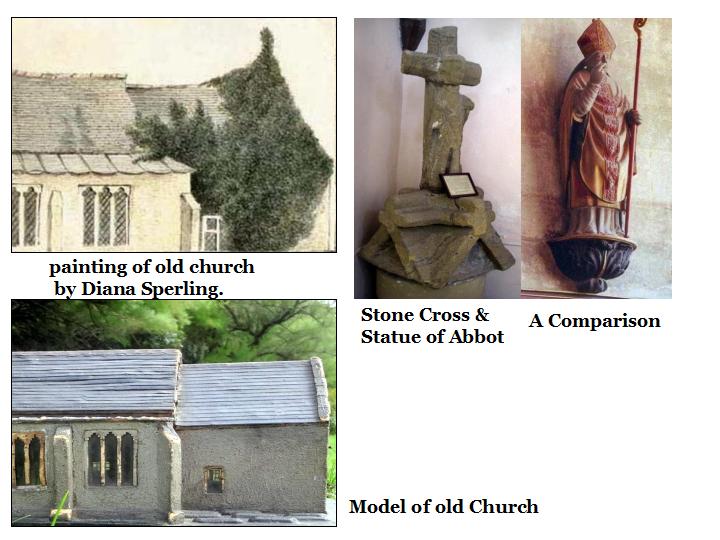 |
| There is a link with the 400 years of ownership of the village by the monks of Forde Abbey in a stone carving that still can be seen in the church. It depicts an Abbot with a Cross behind him. A watercolour by Diana Sperling shows an ivy clad roof of the old church with the cross at the top of the Chapel. The Model below confirms its original position.
|
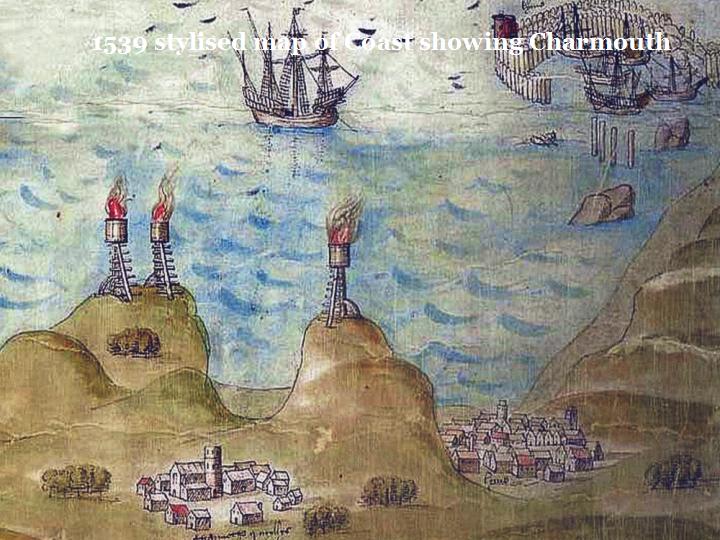 |
The earliest depiction of the Village is in 1539 when King Henry VIII commisioned a plan of the defensives along the Dorset Coast.The beacons are shown high above the village with Lyme Regis and its Cobb in the distance.
In the same year, Forde Abbey was dissolved by the King and Thomas Charde was to spend his last years as Vicar of nearby Thorncombe,whilst Charmouth was briefly to be owned by the Crown. There is a copy of the original Charter dated 1564 in the Dorset Record Office from Queen Elizabeth I where she grants the Lordship of Charmouth to Robert and William Caldwell and their heirs for just £25.5.1d. But their ownership was very brief, as before the year was out they had sold it on to Sir William Petre.
|
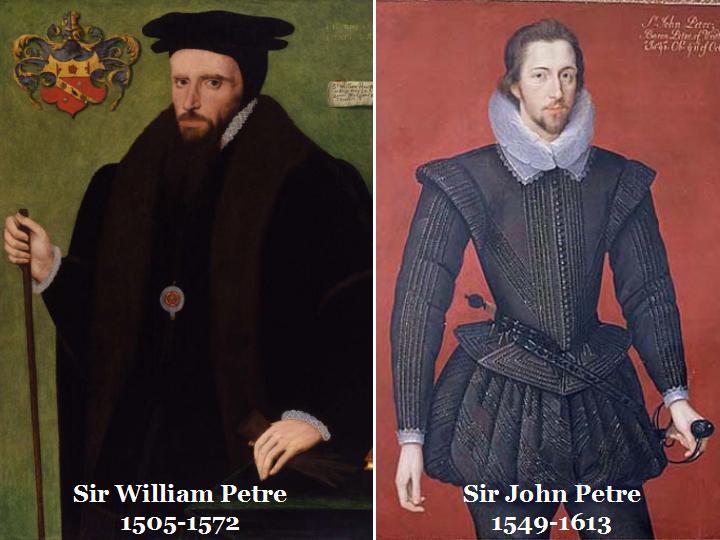 |
It is ironic that Sir William Petre should end up owning Charmouth as he was in charge of dissolving Forde Abbey in 1539.He was immensely wealthy and used his position as Secretary of State for King's Henry VIII, Edward, Queen's Mary and Elizabeth to increase it with the dissolution of the monastic estates. He was known to have 36,000 acres in Devon alone.
The house he had built, Ingatestone in Essex is still home for his descendants. He died in 1572 and briefly his son Sir John Petre owned Charmouth. Although they were to be landlords for just 10 years,there is a record of their time in the Deeds to several houses in the village. Amongst them is “The Elms” on the Street that shows that in 1575, John leased it to Richard Piers of Lyme.
|
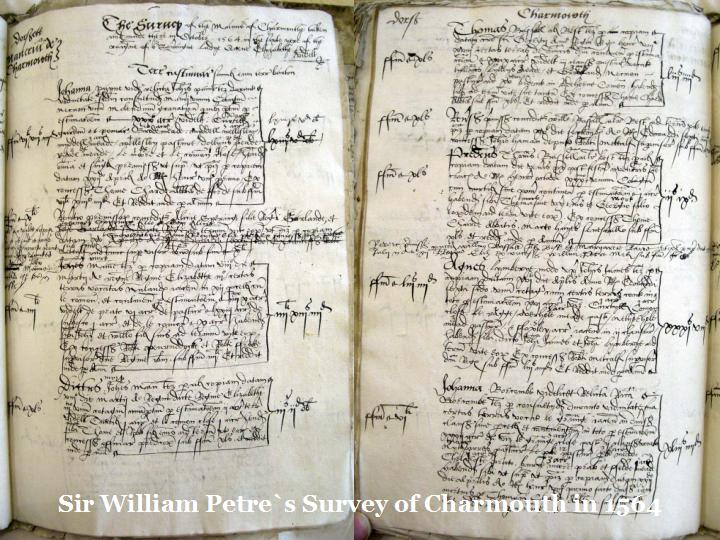 |
| A comprehensive survey was instigated by Sir William soon after he bought Charmouth and can be seen amongst the rental books for the family now kept in the Devon Record Office in Exeter. It details all the tenants and their lands and buildings at that time and provides an insight into the village during the transition from the Abbey. The majority of his tenants occupied cottages along the Street with an acre of land and a further acre of common land which they farmed.There were a number of people who had larger holdings, the most prominent of whom were the Limbrys. A branch of this family lived in what is today' s Charmouth House, but then known as The Fountain.
|
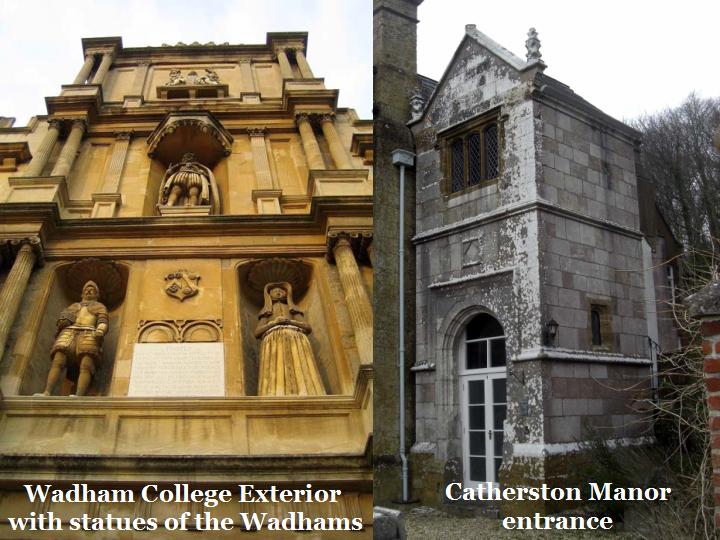 |
| Sir William's daughter, Dorothy married Nicholas Wadham of Branscombe in Devon and with their combined wealth were able to build and endow Wadham College in Oxford which still has statues of them both above it's Gateway. Another branch of the Wadhams were also to become Lords of the Manor of Catherston, which adjoins Charmouth. Part of their original Mansion was later incorporated into the present house as can be seen in this slide. In 1590 the Wadhams added to their Estate by purchasing Newlands in Charmouth from their cousin, Sir John Petre.
|
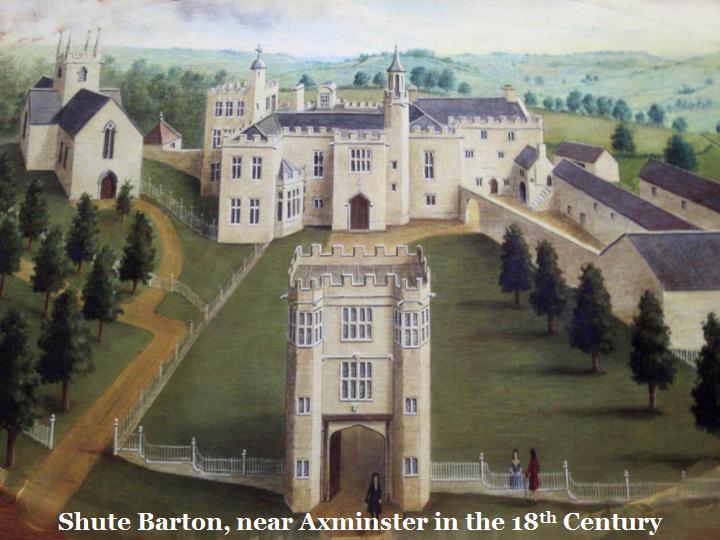 |
| Amongst the many Estates that Sir William Petre owned was that of Shute, just outside Axminster in Devon and about 7 miles from Charmouth. It had been granted to him by Queen Mary. He was to only possess it briefly and in 1560 sold it to William Pole for £300. This gentleman was an eminent Lawyer and had been Justice of the Peace for Devon. He went on to purchase Colcombe Castle near Colyton and in 1575 the Manor of Charmouth from Sir John Petre. He possessed many estates in the neighbourhood and when he died in 1587, aged 73, his eldest son, William,then only 26 years of age was to inherit them.
|
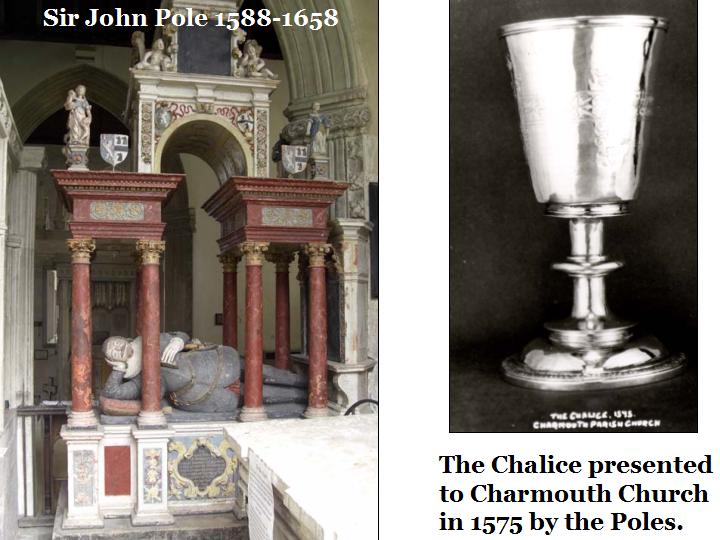 |
| William later erected an impressive monument to his father and also one to his mother, Kathryn, daughter of Alexander Popham, Lord Chief Justice of England, at the Church in Colyton. Their Chapel contains a number of memorials to the family. It was William Pole who in 1575 presented a Chalice to the Church in Charmouth which still exists, though kept in a safe at Salisbury Catheral now.
|
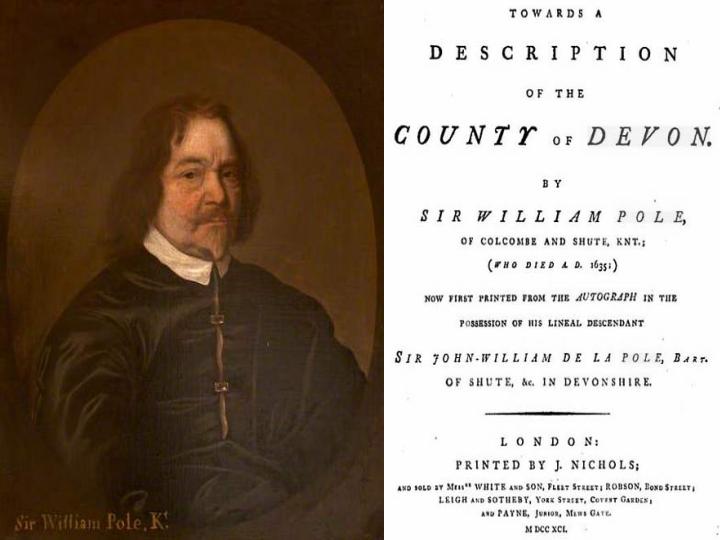 |
| Charmouth was to be governed by Sir William Pole for the next 50 years until his death in 1635 aged 74 . He is famous today as a distinguished historian who produced one of the earliest histories of Devon, although it was printed long after his death. In 1585 he married Mary Perham and they were to have 11 children, but tragically she was to die through a fall in 1605 and he had to bring up the young family. He later married again Jane, daughter of the wealthy Roger How. As well as Shute Barton he was to extend the nearby Colcombe Castle. After his death his son John, was to briefly own the Manor of Charmouth. |
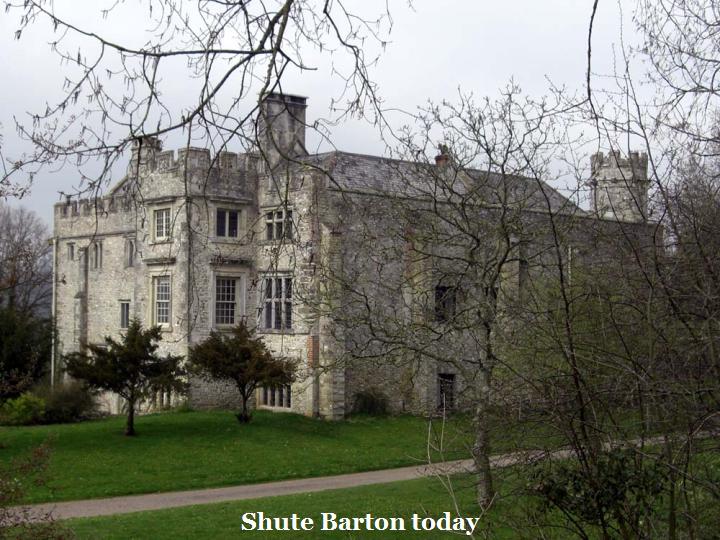 |
A View of Shute Barton, near Axminster today which is occasionally opened to the public by the National Trust.
Although Sir John Pole was to sell the Manor of Charmouth to William Ellesdon in 1648, he retained The Mill and 35 acres of land, which were bought by Robert Knight of Chideock at the end of the 18th Century.
|
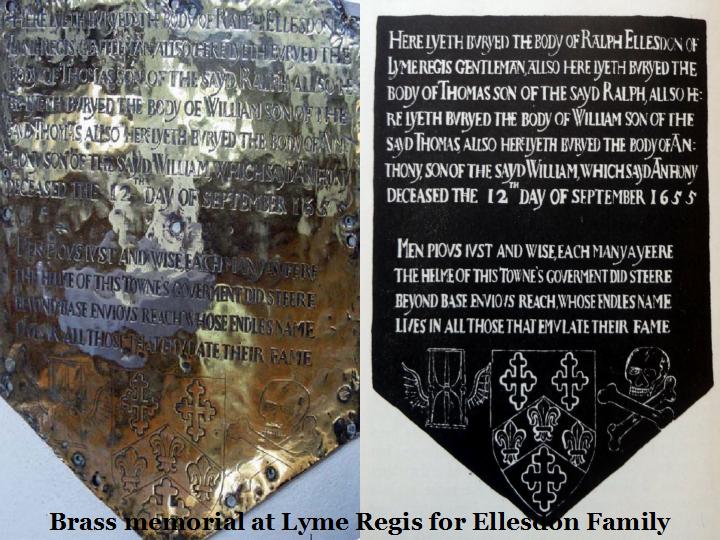 |
| The Ellesdons were originally successful merchants from Lyme Regis and were regularly Mayors of the borough. The Church still has a brass shield which extols them and records 4 generations being buried in their vault. Coincidentally the last is Anthony, father of William Ellesdon, who is shown as dying in 1655. This same gentleman purchased the Manor of Newlands, which today forms part of Charmouth in 1649.
|
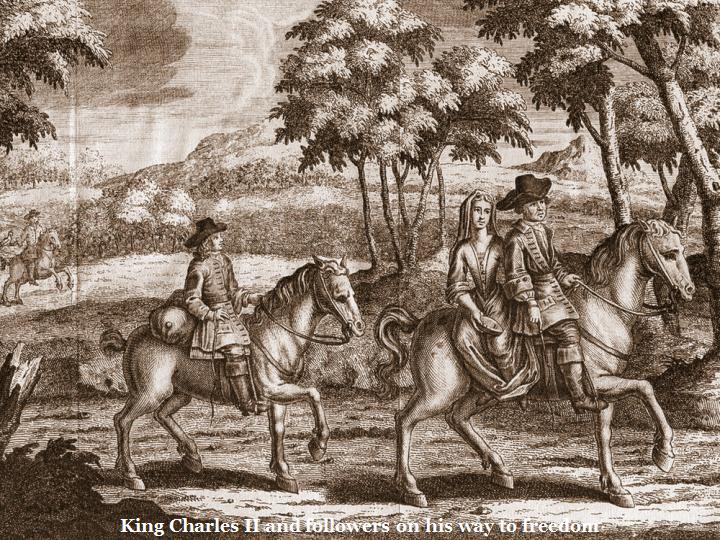 |
| William Ellesdon was a Royalist and held the position of Captain and later Colonel in the army and was to risk his life in support of the King. For that would have been his fate if charged for assisting in his escape.He had been earlier successful in helping Lord Berkley escape across to France after the Battle of Worcester and no doubt would have repeated this with Charles,if it had gone to plan.The King was to give him a gold coin, when he briefly spent the night before the planned escape at a house his father owned at Monkton Wyld, still called "Elsdons". At the same time he promised that when he regained his throne he would reward him handsomely.His Majesty,on his restoration visited the village and granted to him and two successive heirs a pension of £ 300 per annum.
|
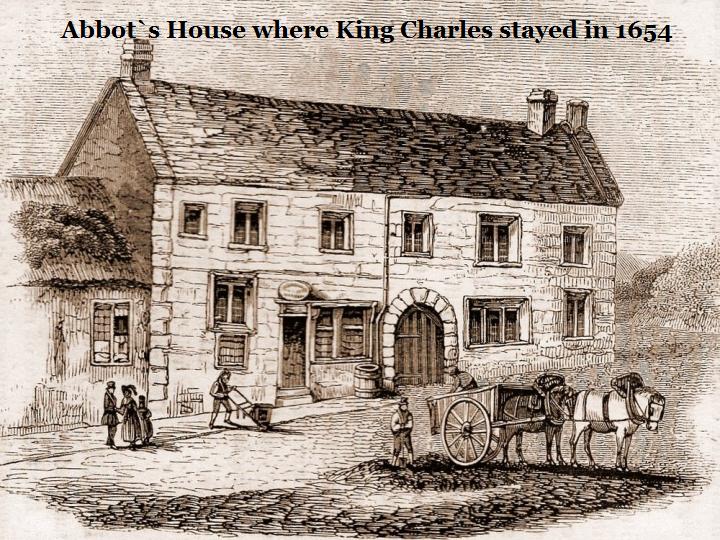 |
| The Abbots House, formerly known as the Queens Armes still stands and this engraving by Carter Galpin gives us an idea of how it may of once looked when King Charles II was to spend one night there in 1654 in his bid to escape the country to France via Charmouth.
There is a plaque above the door way today that records this historic event. |
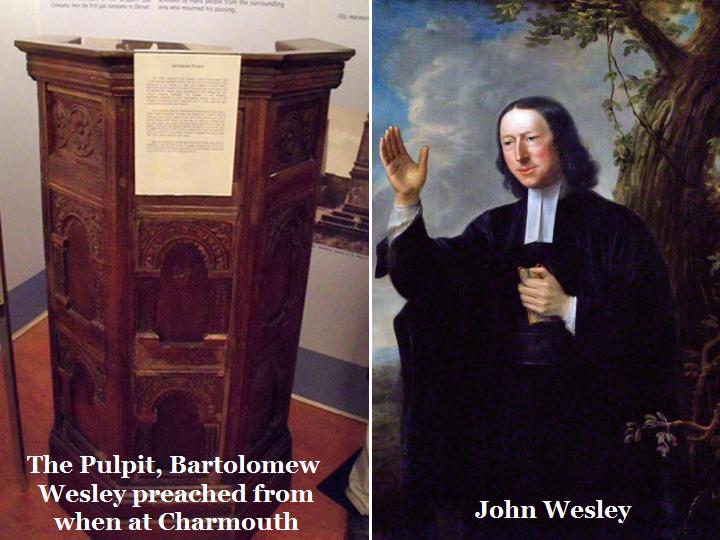 |
| Between 1646 and 1658 the Rector for both this village and Catherston was one Bartholomew Wesley, whose great grandson was to go on and found the Methodist Church. The Pulpit from which he preached in Charmouth can now be seen in the Museum at Bridport.
|
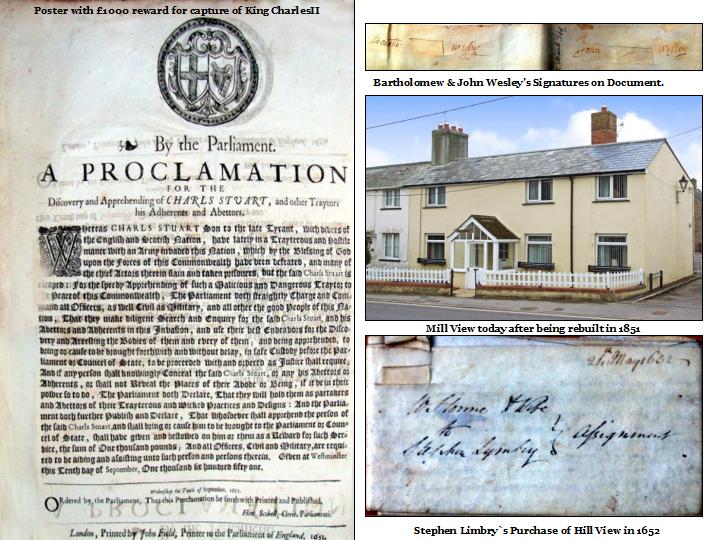 |
A "Wanted" poster similar to this would no doubt have been seen by Stephen Limbry`s wife after her visit to the Market in Lyme Regis earlier that day. It was issued by Oliver Cromwell offering a reward of £1000 for Charles II`s capture. It was to make her suspicious of her husband's actions and as a consequence she was to lock him in their house so that he could not meet the King on the beach at the allotted hour.
In the early morning one of the kings horses was taken to be shod. The blacksmith declared that its shoes had been made in the north of England. When the ostler said that the party of strangers had sat up all night, suspicion was aroused. The ostler ran to consult Mr. Wesley at the church, but as he was reading prayers, there was considerable delay, and Charles was gone before any measures could be taken to prevent his escape.
Bartholomew Wesley and his son, John Wesley are shown are shown as signing an indenture for their house sale in 1668. The property now called "Mill View" stands on the site of the former house where they lived. The deeds still exist in the Dorset Record Office and shortly after the Wesleys moved it was bought by the same Stephen Limbry who was involved in the attempted escape of the King .
|
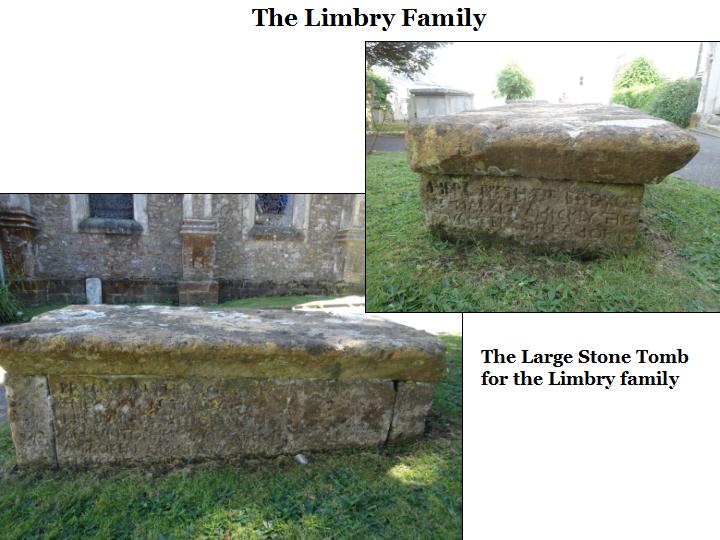 |
| Another connection with this chapter in English history is the massive stone grave near the church entrance to Margaret Stuckley, who was born in 1729 and lived to be 88 and was the daughter of John Limbry. There are a number of inscriptions around the Tomb, most of which are under the ground which no doubt detail former members of this illustrious family,which included Stephen.
|
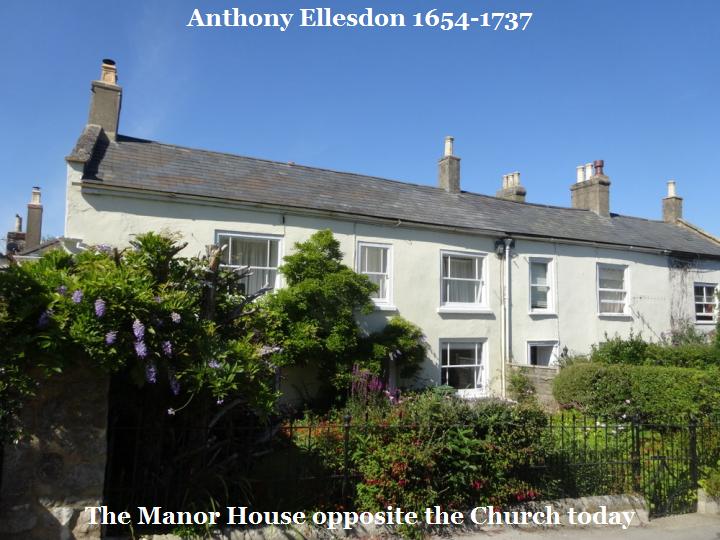 |
| William Ellesdon's son, Anthony was to spend most of his long life in Charmouth and he is often referred to in deeds and documents of the time. He would have no doubt lived in the Manor House, which would have been more imposing than what we see today after being subdivided and altered in the 19th century. In 1716 he married Anne Gale from Angersleigh, near Taunton in Somerset. Sadly he outlived all his family and his fortune and Estates were to be left to his sister, Mary whose sons were Richard and Charles Henvill.
|
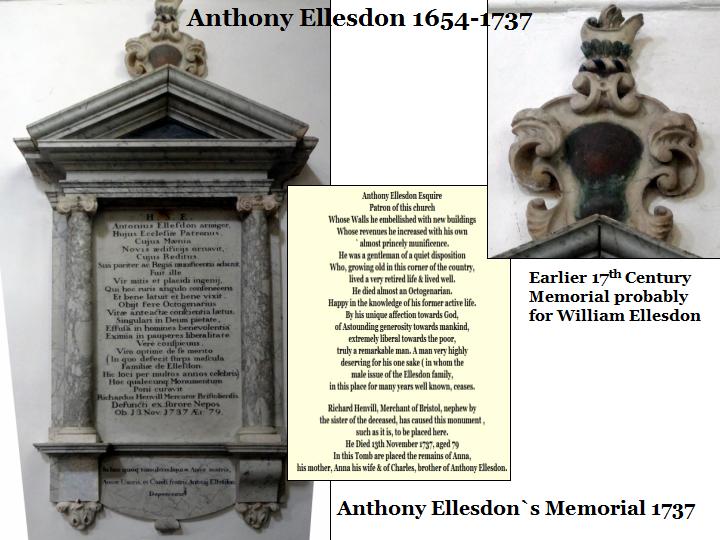 |
His nephew was to commission an elaborate marble monument to his uncle, which was transferred when the present church was built in 1836. He was patron of the church and paid for extensive improvements to it in 1732. From the long description of his acts of charity he appears to have been well liked.
His Will shows him owning property in the parishes of Symondsbury, Lytton Cheney, Winterbourne Stapleton and Winterbourne Abbis in Dorset. It also refers to his father in that “I give to Richard Henvill the use of my medal set round with diamonds which was given by his late royal majesty King Charles II to my honoured father for his loyalty to the said king.”
|
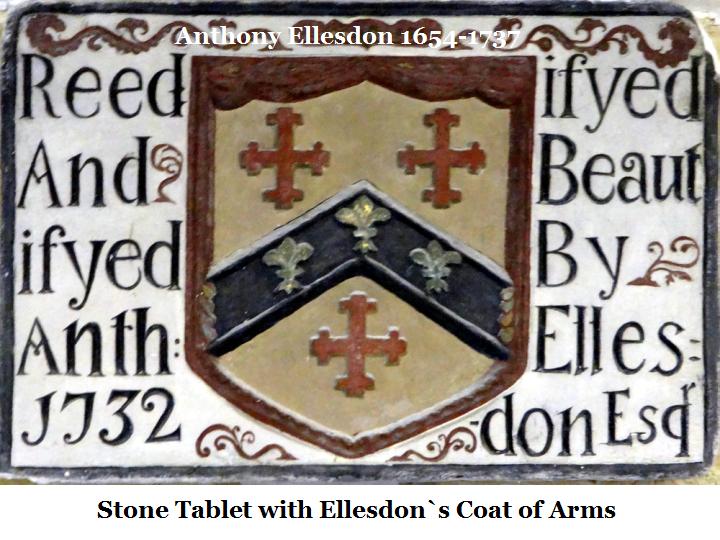 |
| St. Andrews has a painted board with the coat of arms of the family dated 1732, which records the work that Anthony paid for to “Re-edify and beautify the Church”.
|
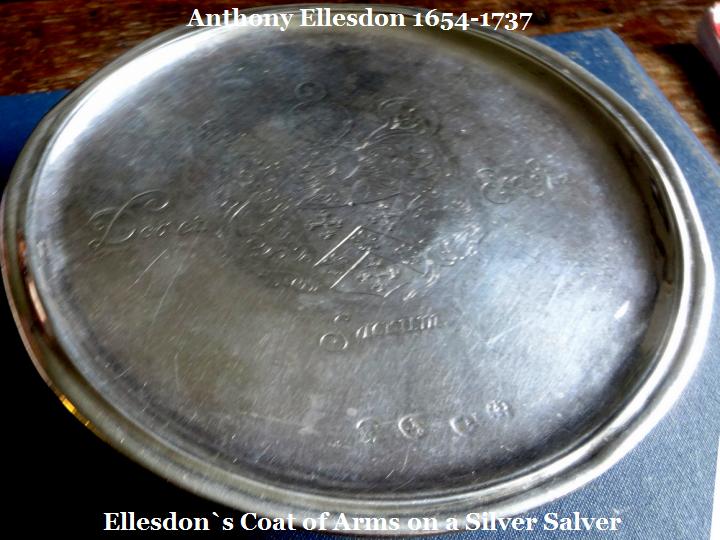 |
A Silver Salver presented by Anthony Ellsesdon in 1716, which is still used today at Services in the Church.
|
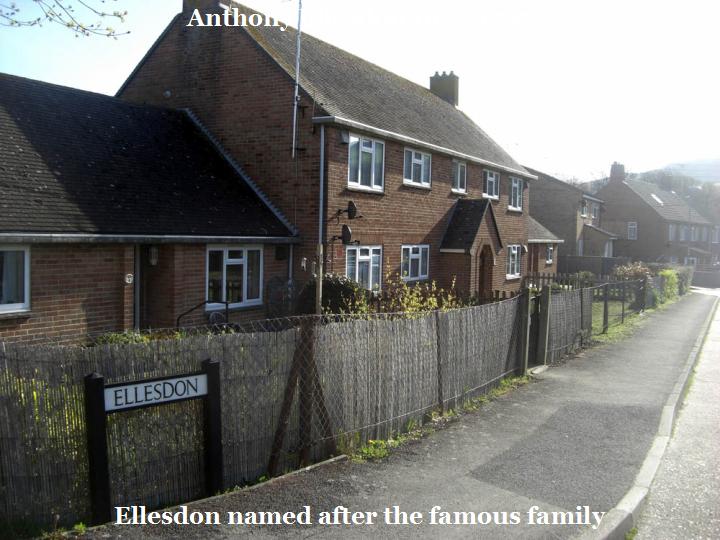 |
| Another reminder of the family is of course, Ellesdon named after the field that was once owned by them on which the road stands. |
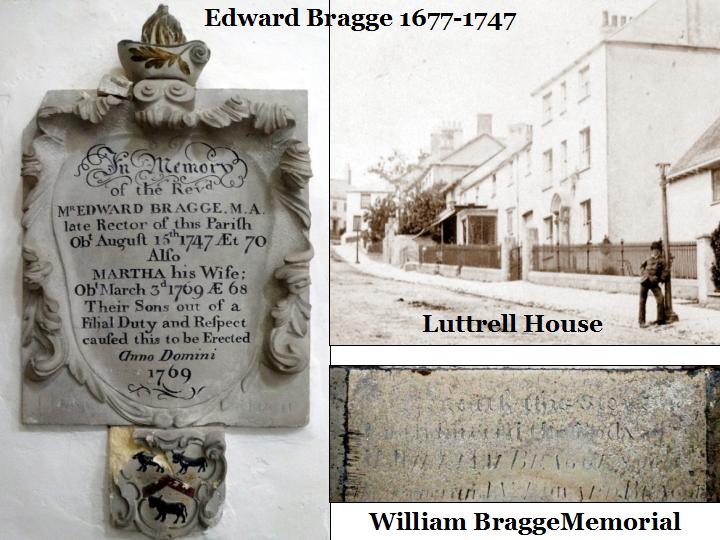 |
In 1673 Joseph Bragge was to become Rector of the Village and on his death in 1708 his son,Edward, was to hold the same position. He was to remain as Parson until he died in 1747. Altogether they would have been Rectors for a total of 74 years. St. Andrews has a magnificent carved baroque memorial to Edward and his wife Martha by the Altar.
Those were the days of good living and Bragge so enjoyed his dinner table that he desired to be buried in it and his coffin was actually made from the same. He and his wife, Martha had 5 sons and the eldest William remained in the village as a Surgeon and lived in Luttrell House. The photograph above shows it before it was refronted. There is a memorial slab to him placed in the church floor.
|
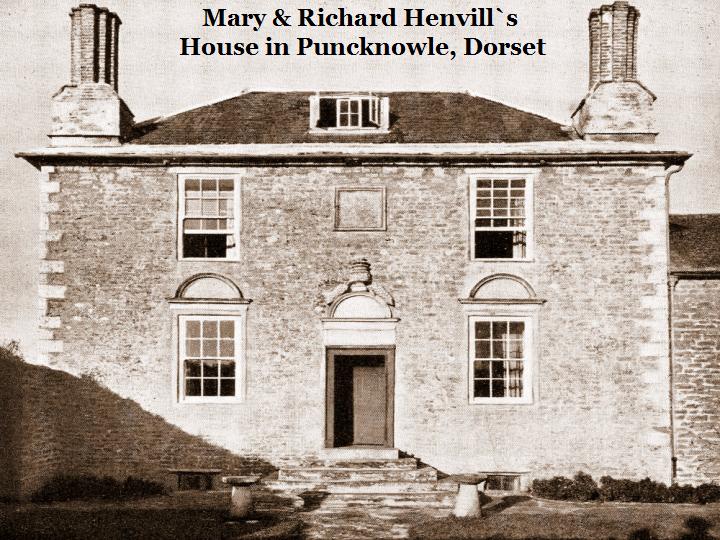 |
| When Anthony Ellesdon died in 1737 he gave a substantial proportion of his wealth to his two nephews, Richard Ellesdon Henvill and Charles Henvill. Their mother Mary had married Richard Henvill and the house they had built soon after still stands in Puncknowle. It has the their initials and the year of 1700 above its doorway. It seems Charles was to stay in Charmouth and married Elizabeth Hodder and both were later buried here. His brother becomes Lord of the Manor, but it is probably Charles who lives in the Manor House. For Richard is often described as a Bristol Merchant and was very active in the Tobacco and Slave Trade.
|
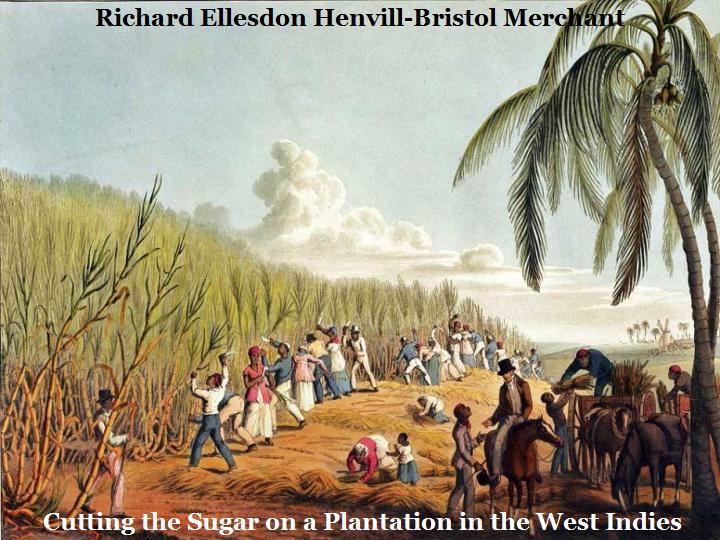 |
He was one of the agents who were responsible for outfitting the ships, making the arrangements for the supply and selling of slaves. In 1744 he gives evidence to the Lords Commissioners for Trade and Plantations that Bristol sent out 40 slave ships per year each with goods on board worth £4000. Another brother Robert lived at the time in St. Kitts in the West Indies.
Richard is only Lord of the Manor for seven years and it is his 17-year-old daughter, Benedicta, who is to inherit the village and be patron of the Church. |
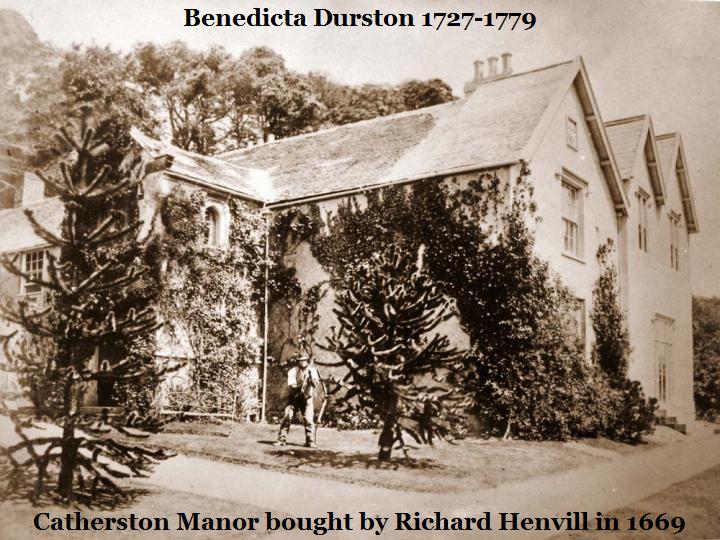 |
In 1760 Benedicta also inherited Catherston on the death of her Uncle, Charles Henville. At the age of 36 she marries the Rev. Joseph Durston, but they are to have no children and she is widowed by 1770. She is living in the village either at Charmouth or Catherston Manor as her signature appears regularly on documents of the time. Her Will shows her leaving her Manor of Charmouth to her distant cousin Richard Henvill and Catherston to his brother, Robert who was a Barrister on the Island of St. Kitts.
The Manor of Charmouth finally ends up being owned by a Merchant living with his family on the Island of St. Kitts in the West Indies. But it is only for four years as he is to die in 1788 and it is put up for sale by Auction.
|
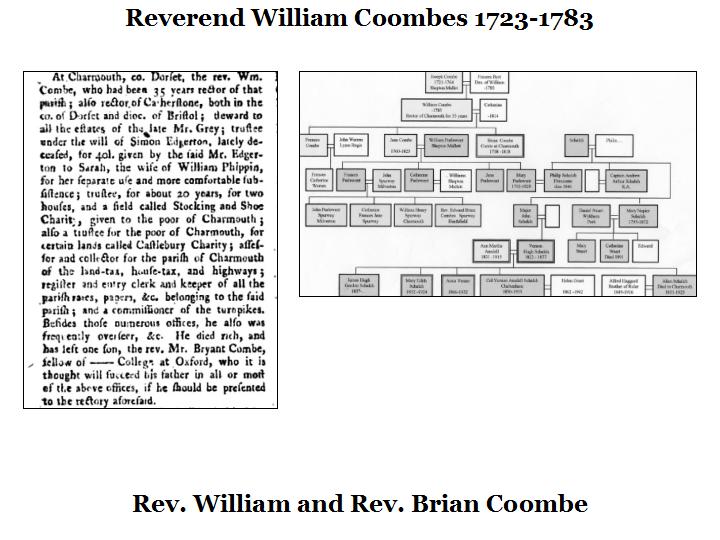 |
| The Reverend William Combe was Rector of Charmouth for nearly 40 years. He was to marry Sarah, daughter of James Syndercombe of Symondsbury in 1755.They have 2 children,Brian born in 1758 and Mary two years later.
His obituary records that he virtually ran the village and was also Rector of Catherston. He was from a wealthy family in Somerset and when he died in 1783 left his son, Brian a substantial fortune. |
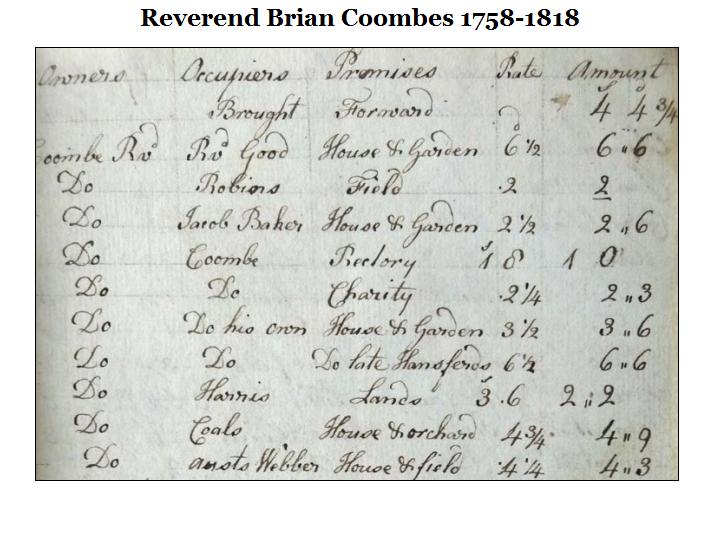 |
| William Coombes son, Brian was expected to be the new Rector on the death of his father, but as this position was chosen by the Patron of the Church, it did not go to him but to John Audain.As the latter was rarely in this country but chose to return to the West Indies, Brian stood in as Curate in his absence. He was also Rector of Catherston. He spent the fortune left by his father on properties in the village as can be seen by the Poor Rates list for 1814 shown in the slide. Amongst these was Backlands and Stonebarrow Farm. He never married and in his Will of 1818, left his substantial estate to his 4 nieces- Frances Purlement, Catherine Williams, Frances Warren and Jane Purlement.
|
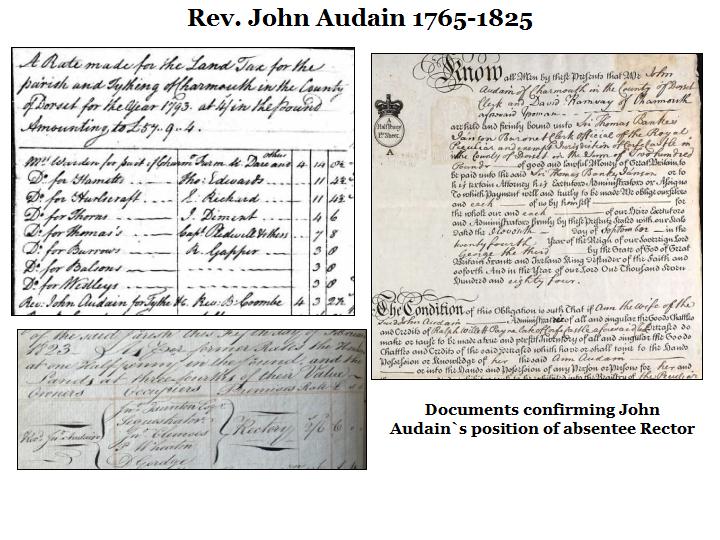 |
The Reverend John Audain was only 18 when he took on the role of Rector. The fact that his Uncle living in St. Kitts was both the Patron and Lord of the Manor of Charmouth must have helped him to obtain the position instead of Brian Coombes.
It would seem that although he was to appear in the village records in this position for 43 years, most of this time was spent in the West Indies. The work of the Church was to be carried out by three able Curates, Brian Combe, Joseph Hodges and Thomas Snow.
|
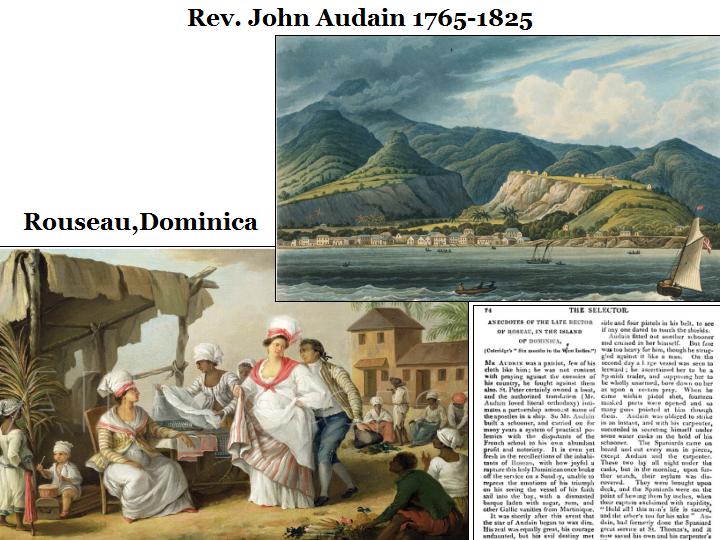 |
During his short time in Charmouth he was to marry Ann Willett and have a son, John. But he was not a typical parson and George Roberts in his History of Lyme Regis in 1834 provides an anecdote about him as follows:
“ He fought a battle at Lyme Regis with an Irish chaise driver, and preached with his usual energy. His preaching carried every one with him: his fighting was good and manly, but not so successful, for the driver eventually beat him”.
He soon tired of the responsibilities of his position and returned back to his home in St. Kitts, and then on to Rouseau in Dominica, where he was to lead a very colourful life which was later witnessed by Coleridge and recorded in his book, “Six months in the West Indies”, an extract is shown on the slide.He was known for his versatility as Auctioneer, Preacher and Privateer. There is an account of his leaving the pulpit to go to sea in his privateer ship, in chase of an enemy's vessel.He was to die in the West Indies,never returning to his post of Rector.
|
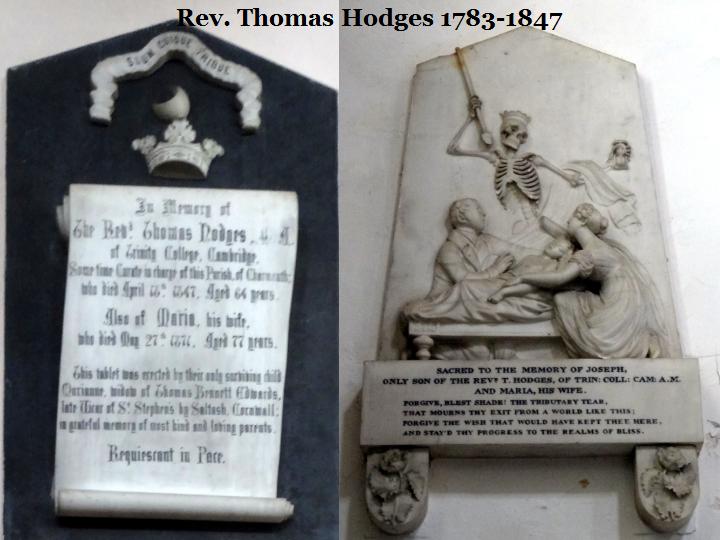 |
The Reverend Thomas Hodges was curate in charge of Charmouth when Audain,was in the West Indies until October 1826. Their son Joseph died when he was 9 and a rather gruesome tablet to his memory is on the south wall of the Sanctuary. He lived at Lutrell House but also owned Berne Farm in Whitchurch and Norchard Farm at Stanton St. Garbriel. He continued to live in the village until,his death in 1847.
The following anecdote was later told by their grandson about them:
"Mrs. Hodges used to buy brandy from smugglers. The excise officer lived at the bottom of the village. He wrote to Mr. Hodges that he was coming down for a few days as he had work to do down here. Mrs. Hodges got very anxious thinking he had heard of the brandy, but she knew well,and trusted, the excise officer`s house-keeper. So she consulted her and she suggested that the incriminating bottles should "be put in a cupboard in the officer`s own house, as the last place he would suspect". This was agreed to and Mrs Hodges brought down the bottles hidden in the vast muff fashionable at the time".
|
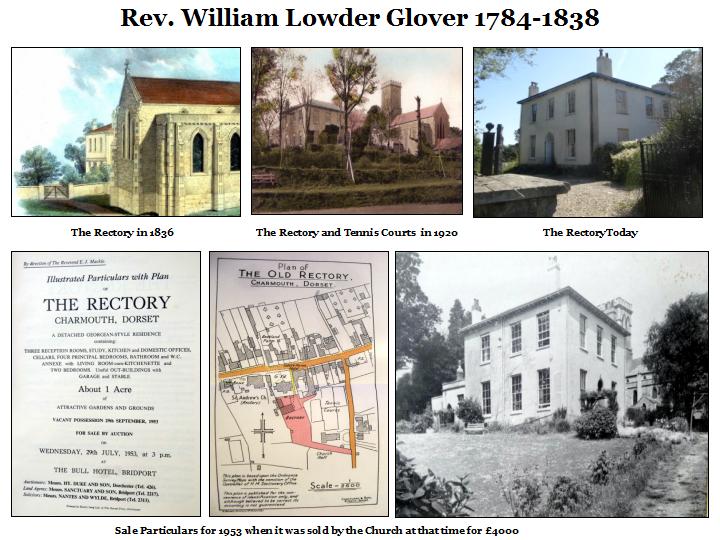 |
| The Reverend William Lowder Glover was Rector for 5 years from 1827. We have him to thank for the Rectory which was built in 1828 on a field. The drive was through the Churchyard and tomb stones were removed and placed against the west wall of the churchyard. This would have been Glebe land as also was the tennis courts field. A new Rectory House of good dimensions has been lately erected , Roberts wrote in his “History of Lyme Regis and Charmouth” in 1834. A century later, Mr Mills, a local builder found chalked on a beam in the roof - "W. Burges, Clifton, Bristol 1827", no doubt the builder of the property. After their time here the Glovers moved back to Bristol and he was a Curate at Bedminster, but died in 1838 aged just 54.
|
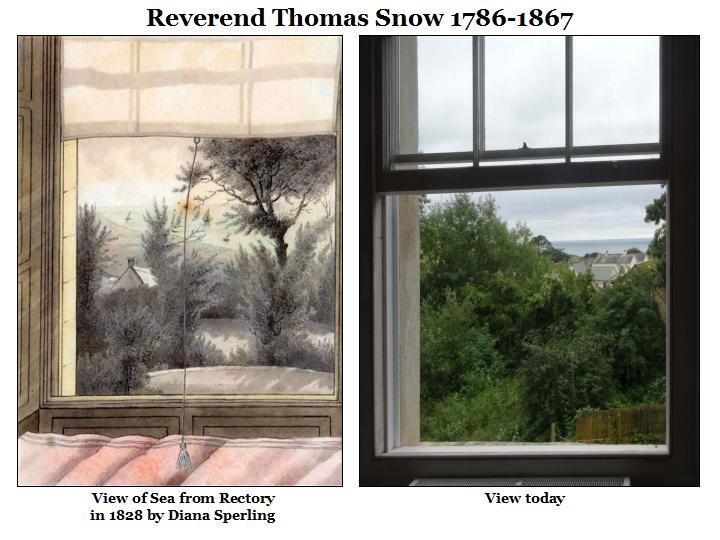 |
| The Reverend Thomas Snow was Curate from 1827 until 1834 whilst Reverend William Glover was Rector. He would have lived in the new Rectory. We are fortunate today in that we have a record of this time through 2 watercolours his cousin, Diana Sperling painted in 1828 through the windows of the Rectory the first is looking out to sea. We are grateful to the present owners of the Rectory for the comparison today.
|
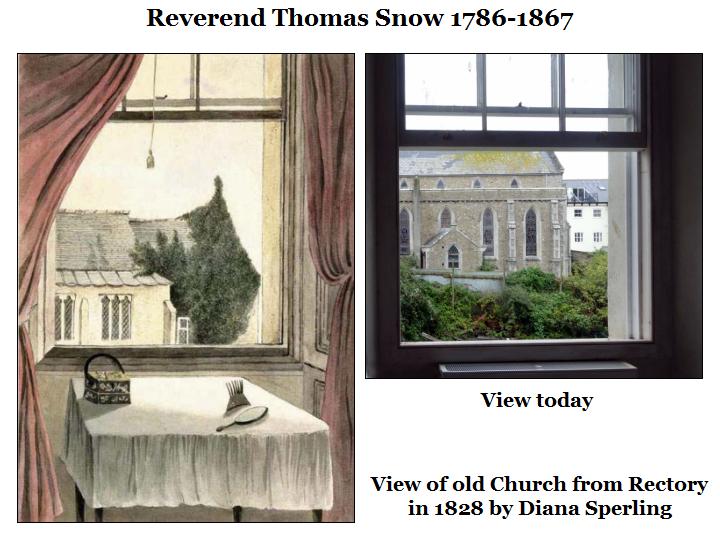 |
| The companion painting is even more interesting as it is the only record of how the old Church looked in 1828 before it was demolished. The view today shows a much higher roof.
|
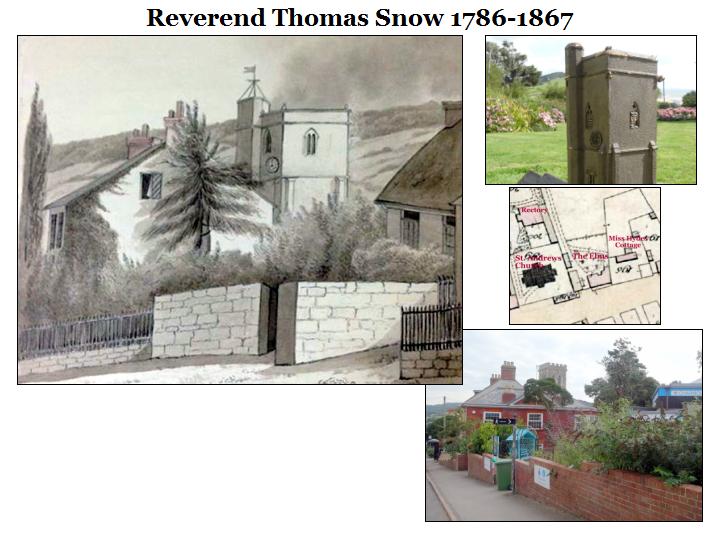 |
| We only came across this unusual view of the old church last week as it is in a sketchbook by Diana Sperling which is coming up for auction soon. It shows the old Church with a weather vane and flag on its tower, which compares well with the model on the right. The building in the foreground is "The Elms". This property was extended in 1900 and the neighbouring cottage owned by Miss Hyde set back from the road was demolished to extend the Garden. The site is now where the Library is today.
|
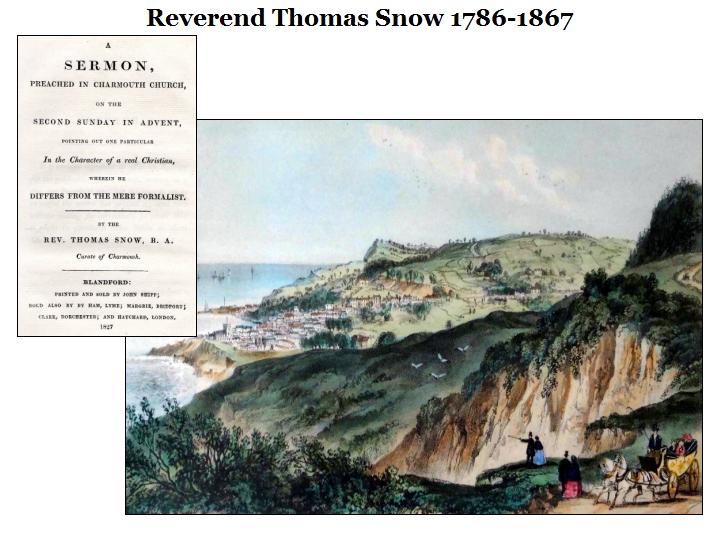
|
Thomas Snow was Curate from 1827-1833. In December 1827 Snow preached a rousing address entitled, "A Sermon preached at Charmouth Church, on the second Sunday in Advent". By this sermon he made clear his Evangelical beliefs.
A Mrs. Mary Brown, writes: "when she was staying in Lyme, heard of a striking new preacher at Charmouth. They took a fly to Charmouth and found that rumour had not exaggerated. Mr. Snow was the finest preacher they had heard. He had returned to the church purified, a burning and shining light. They set off at ten every Sunday morning, remained for the afternoon service and returned for five o'clock dinner. But presently even the road to Charmouth was threatened. Mrs. Snow, after calling on them mentioned that she thought she would go home by the Axminster-Road because, she had remarked a crack in the cliff road. The next morning a butcher and cart fell in a chasm of forty feet."
|
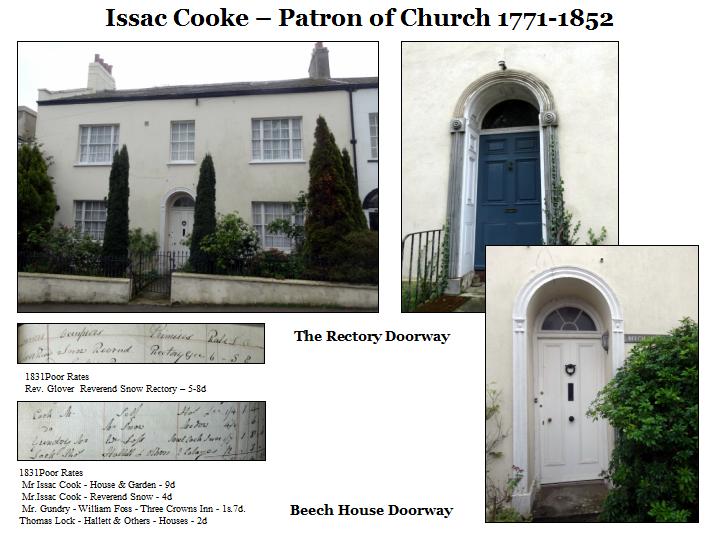 |
Isaac Cooke was Patron of Charmouth Church from 1827 until 1839, during the occupancy of Glover and Hales as Rectors. He lived in Clifton and was a Solictor and at one time Mayor of Bristol. This was also where The Reverends Thomas Snow and William Glover originated from, as well as several other inhabitants. He bought Beech House from William Edwards and may well have been the gentleman who rebuilt it at the same time as the The Rectory as they are very similar as shown by the doorways in the slide. The 1831 Poor rates show Isaac Cooke living and owning Beech House, with Thomas Snow living in the new Rectory and renting a field from him, which was probably the piece of ground Sandford House, Littlecote and Carrum House were later to be built on by Samuel Dunn.
Issac Cooke was only there briefly as the 1841 Tithe map shows it unoccupied and soon after John Hodges, the butcher moves in and opens his shop in the adjoining Winton House.
|
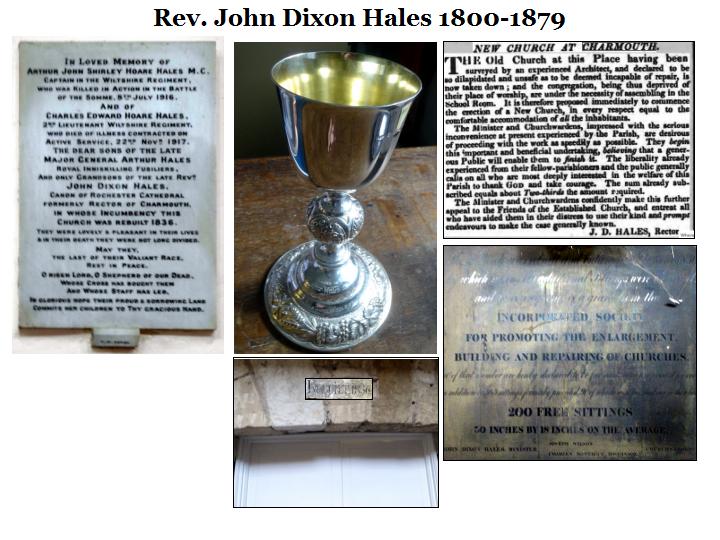 |
The Reverend John Dixon Hales was Rector from 1833 until 1839, when he resigned the Living. It was during this time that the church was rebuilt. For as the population of the village expanded, more seating was required and a Gallery was built to accommodate them. When this still was not enough by 1835, it was proposed to enlarge the building with an aisle on the northern side. Mr. Charles Wallis of Dorchester, an architect was instructed to carry out a survey of the ancient structure and reported that “he had never seen so dilapidated or unsafe a building and that it was necessary to build a new church”. The whole village worked with enormous energy to raise the money. The numbers of residents, who subscribed, was 334 whose subscriptions came to £1221.The number of friends outside the parish was 375 whose donations came to £1130 making a total of £2351. The final cost came to £3098, the balance coming from grants and sale of material from the demolition. During the year it was built the Diocese boundaries were altered and the Church came under Salisbury once more. At the same time it was renamed St. Andrews instead of St. Matthews, probably as he is the patron saint of fishermen, with its links to the sea.
|
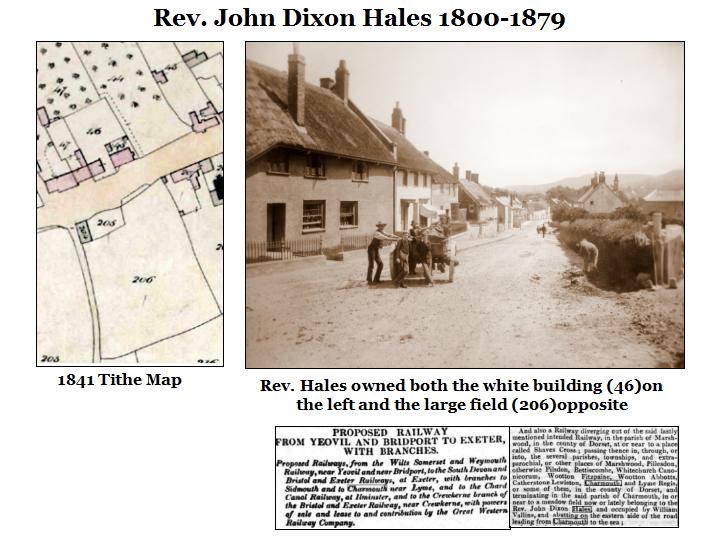 |
The Reverend Hales was to buy "Pear Close",where the parade of shops is today. The building that is the Pharmacy was originally a Carpenters work shop.He also owned some property on the other side of the Street, including what is now the playing field. A Railway was proposed on this site by Sir John Hawkshaw in 1874, but never came to fruition.
Hales was to go on to be a Canon at Rochester Cathedral. A Memorial in the church records the death of two of his sons during the First World War. |
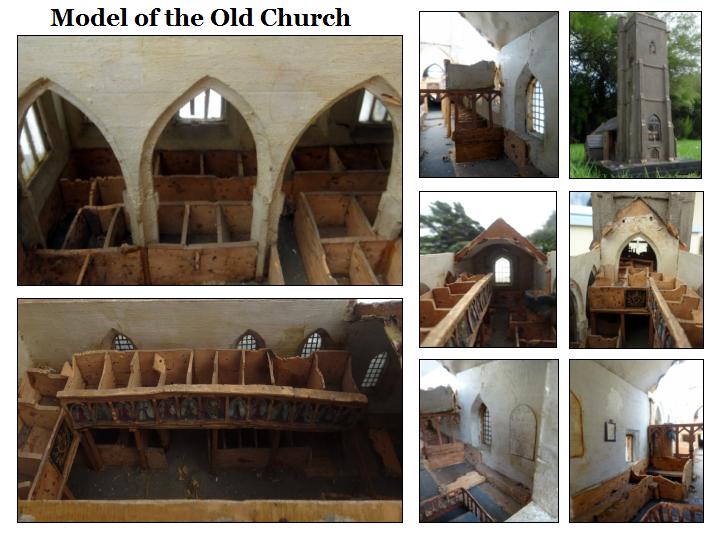 |
| Before the old Church was demolished in 1835, Samuel Dunn, the Clerk of Works had his son in law, William Hoare make a detailed model of it which we have on display tonight. Here are just a few images of the inside with its boxed pews and gallery which are revealed when the roof of the model is removed.
|
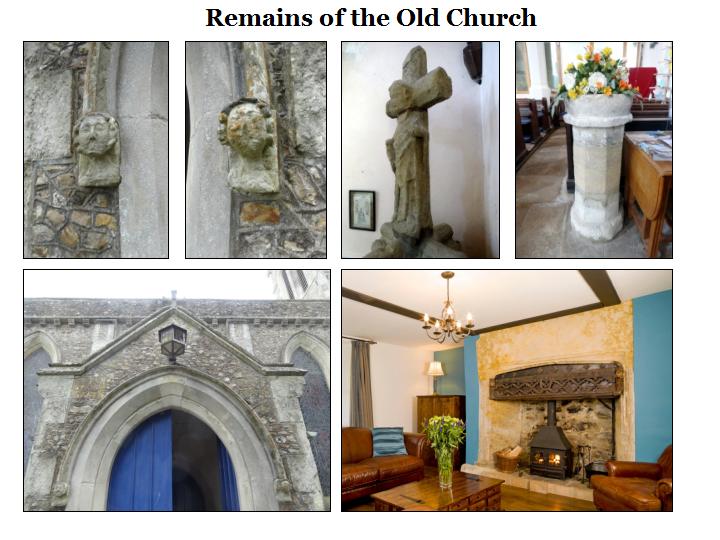 |
There are many remnants of the former Church to be seen today. The slide shows just some of these included are the:
Carved stone heads that graced the original porch.
The
14th century Stone Cross and Abbot, already mentioned
Early 16th century Font
Part of the original Screen that was reused as an over mantel in The Old Manor, opposite the Church.
|
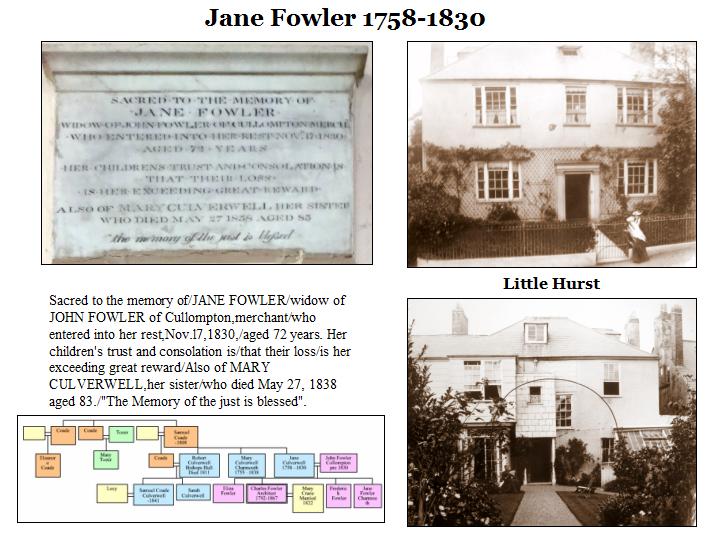 |
It was always a mystery why a village should end up with a Church building designed by one of the country's greatest architects. But a glance at the memorials in the Church gave us a clue, For one is in memory of Jane Fowler, who it turns out was Charles Fowler`s mother who spent her last years with her sister, Mary Culverwell in Charmouth. Both were widows who lived at Little Hurst, in what is now the Doctors Surgery. |
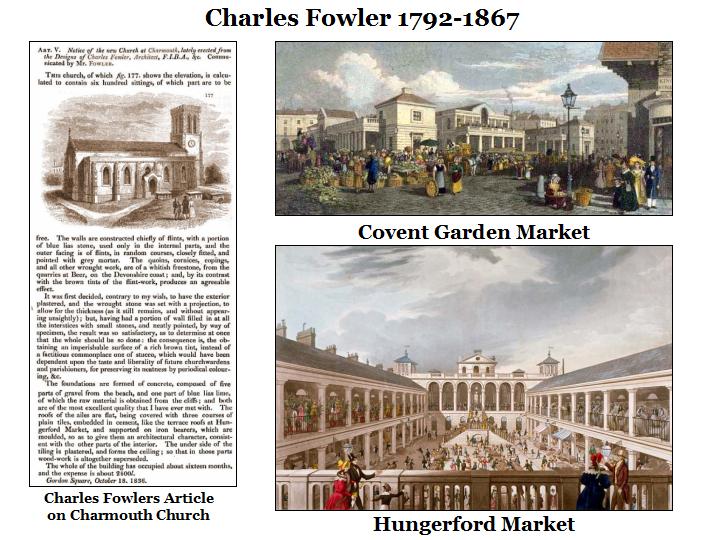 |
| By the time Charles Fowler was designing the Church in Charmouth he had already achieved fame with his highly original accomplishments on Hungerford Market and then Covent Garden Market in London. After he had finished at St. Andrews he wrote a detailed letter to “The Builder Magazine” explaining its construction with an attractive print of the finished church as shown in this slide.
|
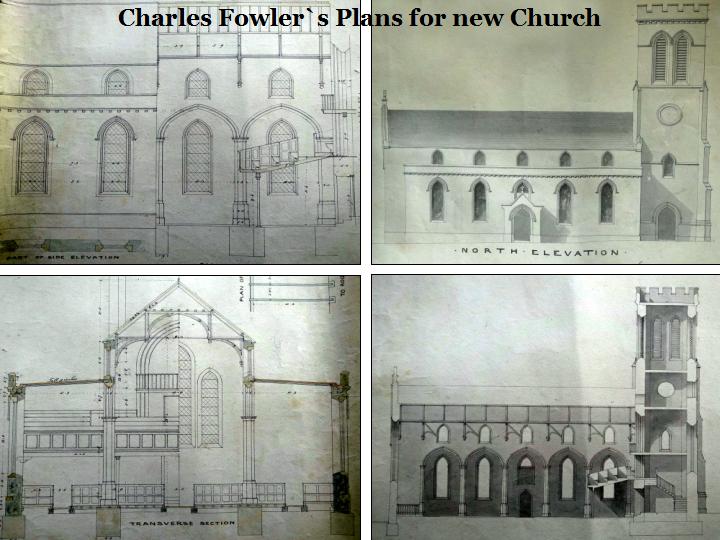 |
These are some of the original drawings and plans which Charles Fowler drew for the builders of St. Andrews. With it are pages of correspondence on what the various workmen were expected to do. They are amongst the treasures the Church still possesses and are on display tonight. |
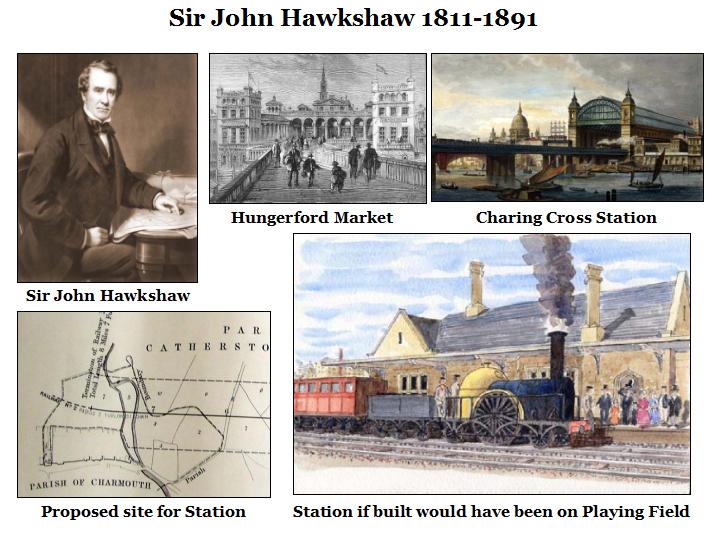 |
John Hawkshaw, one of the Country`s greatest railway engineers spent his first five years working in the office of Charles Fowler. Their paths would later cross again when a new railway station at Charing Cross was needed and Hawkshaw won the commission. But it meant the end of the short lived Hungerford Market designed by Fowler which was demolished to make way for the Station buildings in 1863.
In the same year Hawkshaw was working on this project he had bought most of the land up in both Lyme and Charmouth with the intention of putting a line through to Bridport. The station would have been on the playing field. Sadly it got thrown out by parliament, due to pressure from Great Western Railways. |
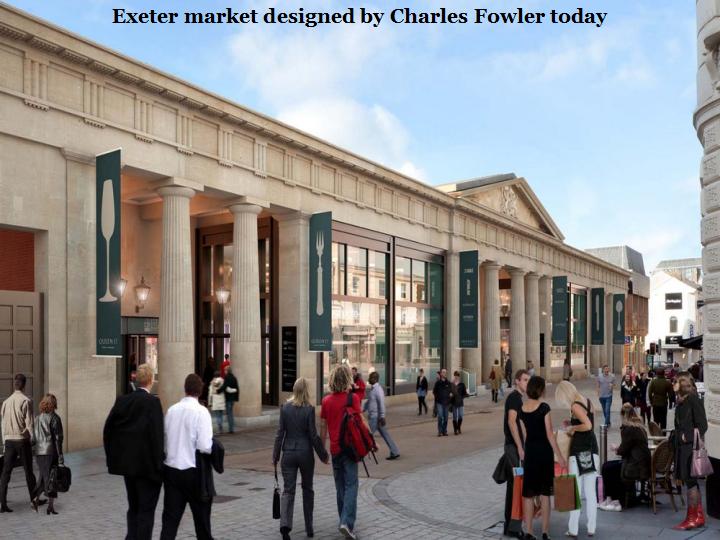 |
The Market Building in Exeter was designed by Charles Fowler and after restoration has proved a popular destination for shoppers. |
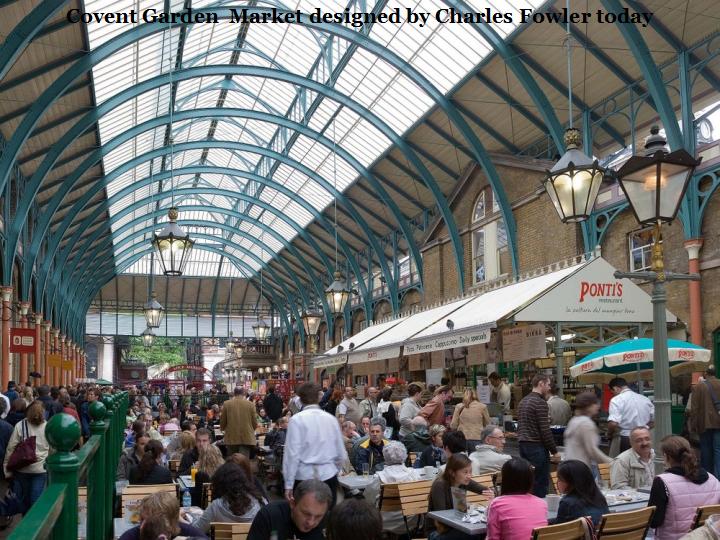 |
The Covent Garden Market buildings designed by Charles Fowler now have a different purpose and are extremely popular, as can be seen in the slide. |
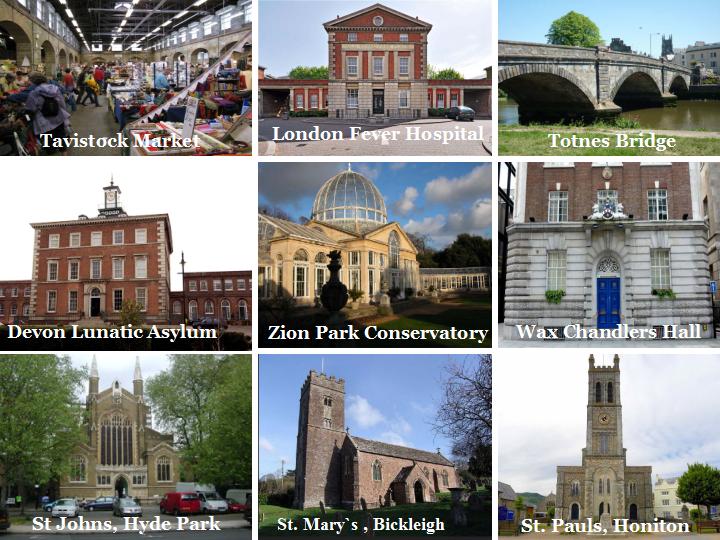 |
These photos are representative of just a few of the many buildings designed by Charles Fowler. They show the variety of styles that he would undertake. He was especially skilled at Market Buildings and designed both the Lower and Upper Markets at Exeter as well as Hungerford and Covent Garden Markets. |
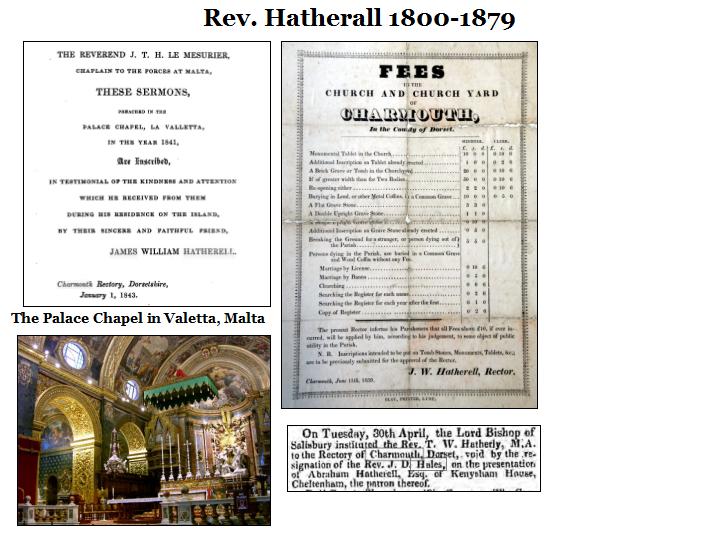 |
The Reverend James Hatherell was briefly Rector from 1839 to 1843. His father, Abraham of Cheltenham was Patron of the Church at the same time. In 1842 his wife, Eliza Cooke died aged just 34 in Valetta and was buried in Malta. He seems to have had his roots in that island and published a number of sermons that he had preached in the Palace Chapel. An interesting document has survived from his time in the shape of a list of charges for the Church yard which is shown on the slide. |
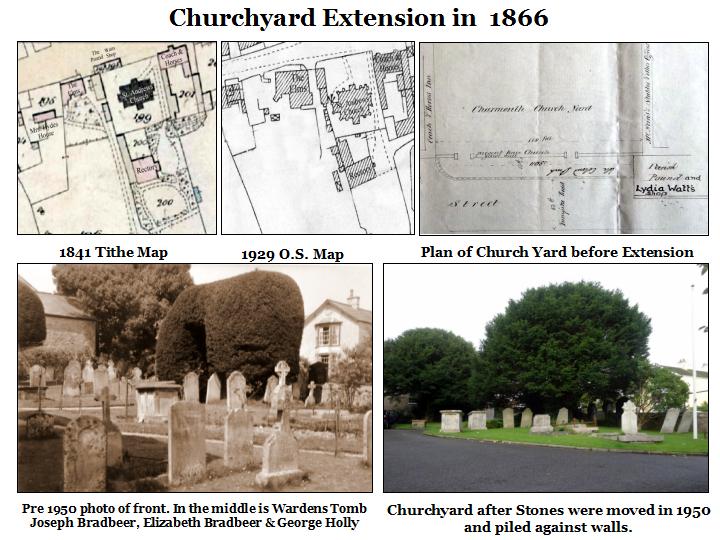 |
When we see the stone wall that fronts on to the Street, we would assume that it has been there for centuries. But this is not the case for originally a Butchers shop and an adjoining Pound for cattle formed an obstacle into the Street. The Church wardens with the help of Mrs Stuart bought the old building and demolished it and were able to extend the Churchyard 20 feet. But in 1950, most of the gravestones were removed and placed against the sidewalls where they remain. |
 |
The Reverend Edward Rose Breton was Rector of Charmouth for 34 years and took over in 1843 from James Hatherall. We are fortunate today to have the wonderful Stained Glass Windows that were commissioned by him and are shown in the slide. Two of the windows are in memory of two of his children who died young. He and his family are buried in a number of Graves by the Church wall at the front. The foundation stone for the new school in Lower Sea lane was laid on 26th August 1869 by Mrs Breton, the Rector's wife. The land it was built on was formerly part of the Glebe belonging to St. Andrews.
We will have an interval now and return to talk on some of the families associated with Charmouth.
|
 |
| We hope to cover most of the Memorials displayed on the walls of the Church. The majority would have come from the previous Church which was demolished in 1835,and we are fortunate that they were preserved.
|
 |
Some are quite elusive, amongst them are these four displayed on the slide. The first is for Sydenham Vere, who came from an illustrious Ilminster family and is described as a Surgeon.
The second is Mary Harris, who is shown as renting a house from John Ridges in 1811 in the Poor Rates List. But we have been unable to find out who her husband, Stephen was.
The next memorial is a little easier as the Reverend Joseph Good rented a house from Brian Coombe, who was the Curate, from 1805 until his death in 1817. He may well have been a friend and helped with his parochial duties.
Finally we have James Collier, esquire. The Poor Rates show him briefly renting a house from Robert Knight. But after his wife died here in 1823, it would seem that he moved to Dodington in the County of Staffordshire.
|
 |
| The inscription on this memorial gives no clue to the life of this Gentleman. But thanks to the wonders of the internet, it would seem that he was a nationally important figure. Again he would have rented one of the finer houses with his wife towards the end of his life and has a fine tombstone in the Church yard. He was the Surgeon, both to King George III`s wife, Queen Charlotte and other members of the royal family. He was based at St. Georges Hospital in London, which survives today as "The Lanesborough Hotel". It was here that he worked with Edward Jenner on Inoculation. A parliamentary report of 1802 describe him having carried out 1500 inoculations with vaccines with no untoward symptoms, including three of his own children.
|
 |
Mary Napier Stuart was to make a tremendous impact on Charmouth, the results of which can still be seen today. Her maiden name was Schalch, a family originally from Switzerland who had made a fortune as Master Founders at Woolwich Arsenal in the 18th century. She had married Daniel Stuart in 1813 and they lived both in Harley Street and Wykeham Park in Oxfordshire. He had amassed a fortune from two newspapers “The Morning Post”and “Courier”, which had huge national circulations in their day, by employing writers such as Samuel Coleridge, Robert Southey and William Wordsworth.
He died in 1846 and his widow, Mary moved to Charmouth in 1855, where her brother, Philip Shalch lived. This gentleman had married Mary Purlewant, a niece of the Reverend Brian Coombes, who had left Stonebarrow and Backlands Farm to her and her husband.
Mary Stuart bought three ancient cottages in the village and built “The Court” in their place.She was not happy with the adjoining Almshouses, so she had three new ones built for the occupants in Lower Sea Lane and had the old ones demolished. To safeguard her view towards the sea, she next bought the field opposite, now known as Fountains Mead. Finally in 1870 she purchased her late brothers farms and became Charmouth`s largest land owner. |
 |
| Mary Napier Stuart was a great benefactor to St. Andrews and commissioned 2 stained glass windows, one of which was for her brother Philip Shalch and his wife, Mary. She also financed the purchase of the additional strip of land to extend the church yard at the front in 1861, although part of it was for her own families Graves. The font, still in use today was erected in her memory by her daughters,Mary and Catherine Stuart and Lady Baynes.
|
 |
| Another interesting memorial is the one to Edmund Cleeves Palmer, who was found to be an ancestor of the present day owners of the Brewery, one of whom is named after him. The family tree shows him to be an uncle of the two members John Cleeves and Robert Henry who founded Palmers at the end of the 19 th century. Edmund also had a brother, Captain John Palmer. R.N. who lived in Charmouth and whose gravestone records him dying in 1878, aged 74. The 1871 Census also shows his sister Ann living with them at Little Hurst, where the Surgery is today. They may well have drunk at Royal Oak next door which is still a Palmers Pub.
|
 |
Captain Matthew John Liddon was the grandson of James Warden, the gentleman who had died in a Duel. His mother, Anne Warden had married Matthew Liddon from Axminster in 1789 and had five children, Elizabeth, Sophia, Ann, Lucy and Matthew. Her husband who was a Captain in the Royal Navy died in 1803 and she had to bring up her young family.
On the death of her mother, Elizabeth Warden in 1798,she was to inherit both Langmoor and the Manor of Charmouth. It is said that she had to mortgage Charmouth to pay for the upbringing and school fees of her children. Although she owned Langmoor Manor, she was forced to rent it and lived in Melbourne House, another property she inherited. The 1841 Census shows her living there with her daughters, Sophia and Lucy. Another daughter, Ann married Captain Richard Spencer and lived for a time in Lyme Regis, but later, after he was knighted moved to Australia, where he was appointed a Governor in Albany.
On the death of his Mother, Captain Matthew Liddon was to briefly become Lord of the Manor of Charmouth. But in 1854 he and his sister, Lucy sold the Estate to George Frean of Plymouth for £9100. By then Matthew was living in Andover in Hampshire and the Church is fortunate to have a memorial to him and his family. Both his sisters continued to live the rest of their days at Melbourne House.
As a postscript, in 1944 a descendant, Prudence F.Liddon Tosetti was born, and christened in Charmouth church.She was the great great grand daughter of Captain Matthew Liddon and niece of Harry Liddon R.A.F. killed in action on 5th May 1943 whose name is on our War Memorial.
|
 |
| This Slide shows three paintings now kept in Albany, Australia of Ann Liddon as a child with Langmoor Manor, Charmouth in the background. The others are of her as an adult, by then Lady Spencer and her husband, Sir Richard Spencer
|
 |
| There is a fine stained glass window to the memory of Andrew Tucker who died in 1868, aged just 49. and also a Stone Cross above the grave of his wife Eliza Lockyer who had died young at just 32 in 1865. Andrew was an Attorney, whose father, also an Andrew,was Rector of Wootton Fitzpaine. The 1861 Census shows him living at The Cottage, now known as Albury House with his wife and servants. It was during his ownership that the stables were built employing Samuel Dunn and William Hoare.
|
 |
| It has always been a mystery as to what had stood in front of the arched patch at the front of the church. But thankfully Ted Whatmore was able to enlighten us and actually show us the marble memorial that had stood there until the 1990`s and had just fallen apart. Fortunately the pieces were removed and are now in the Belfry, waiting no doubt one day to be restored back into its original position. They relate to a Julia Spiller and her father John Robins who had bought a large three storey building known as “Sea Horse House” which had been built in 1803. He and his family originated from Clerkenwell in London. The memorial is rather sad in that the daughter had died young and it is her son James Robert Spiller who inherited the property. He was to sell it in 1883 to Henry Dyne,who in turn conveyed it to Walter Salisbury, husband of Elizabeth Holly, whose father owned the neighbouring Charmouth House, which he ran as an Hotel.
|
 |
| Dr. Norris was the village doctor for a great number of years and lived at the Elms. He was Captain of the Volunteers and Rectors Warden. He was also a collector of fossils, a consignment of which he sold to the Geographical Survey in 1878 for £53. He married a total of 4 times, but when he died he was buried with his second wife,Frances who was his favourite and after her death he had married Emilia Marryat. In 1867 he established Charmouth Village Hospital, which was converted from two cottages, that stood next to the former New Commercial Inn at the top of the Street
|
 |
| The Church has a brass plate recording his son, Hugh Leigh Norris, who lost his life at the Battle of Jutland during the First World War.
|
 |
When James Warden bought most of the village from Charles Henvill in 1788 he quickly sold a portion off to the Reverend Brian Coombes and also the Manor House, which was bought by a local builder, Robert Davie. On Robert`s death in 1803, the property was purchased by Simeon Bullen whose family were to live there until 1887, when they moved to Catherston Manor. The Bullens trace their lineage back to Jeffrey Bullen, Lord Mayor of London in 1466, who was the grandfather of Ann Boleyn.
Simeon Bulen married Elizabeth, daughter of William Fitzherbert of Chideock, and their youngest son, John was to commission the fine marble monument we have today on his father`s death in 1822, aged 75.
|
 |
It was John Bullen who in 1846 paid for and installed the Organ, which replaced a Minstrels Gallery, part of which can still be seen, where Church Musicians would have performed originally.
The 1851 Census for Charmouth show John as a retired Solicitor living in the west part of the Manor House and his son Lieutenant Charles,occupying the other part with his wife Mary. The Will for John, who died the following year reveals that his part of the Manor house was to go to his great nephew, John Bullen Symes.The other part was to remain with his son, Charles who was in due course to rise to the rank of Captain in the Navy. Charles continued to live there until his death in 1884 and was buried in Charmouth Church. The present Pulpit was installed the following year in recognition of him.
|
 |
| It was his nephew, Colonel John Bullen Symes Bullen who was to inherit a fortune and purchase the neighbouring Catherston Estate in 1887 and rebuild the existing Manor House, where he died in 1938.
The photograph shows him passing the George Inn at Charmouth.
|
 |
| One wonders why after at least four centuries as a hostelry, The Fountain Inn closed its doors in 1811. It was at the height of The Napoleonic Wars, which may have affected its trade. But close it did and was bought by Thomas Gordon and his wife Jane. They already owned a large estate at Middleton Court, Huish Champflower in Somerset, and may have decided to retire to the coast. He would have been 52 and as the memorial records, lived on to reach the grand old age of 96. Both he and his wife died in 1855 and the House with 5 acres of adjoining land was inherited by their nieces, Mary and Louisa Short, whose graves adjoin theirs at the side of the Church. Their property was to be sold to George Holly and became an Inn again and was renamed Charmouth House, which it remains today, although its day as a Hotel have long passed.
|
 |
| This Brass Plate which records the memory of Lieutenant William Mandeville Sankey, is somewhat of a mystery as we cannot find anything about either him or his family. But as the memorial relates to his staying as a boy at the Rectory with the Reverend Spencer Simms, that may be all we have to go on. It records that he died at Ypres on March 23rd 1918. from wounds received the previous day,aged 23 years and was the only son of Colonel A.R.M.Sankey.
|
 |
| This attractive Marble Memorial is to Elizabeth Poulson who after losing her husband, George moved with her daughters to what is now called "Charmouth Lodge", but originally "The Limes", after the trees that grew in the front Garden. Her father was David Davies, a Surgeon in the Royal Navy, but there is also a reference to him holding that position for King George IV. Elizabeth originated from Clifton, near Bristol , as did other Charmouth families in the early 19th century. The 1851 Census shows her with one of her daughters and a servant residing in "The Limes". After her death her daughters carried on living in Charmouth, this time at no. 2 Hillside
|
 |
There are two brass plates in St. Andrews to Charles Alexander Innes and Maxwell Campbell Innes,who came from a very distinguished family. Charles was a Surgeon who had been present at the Siege of Sebastapol in 1855. He then went on to India and took part in the Siege of Delhi. His father was Lieutenant Alexander Innes who had fought at the Battle of Waterloo. In 1915 Charles was living at Lynwood as neighbour with his daughter, Susan Bush at Grasmere and his son Major Hubert at Omega. Another son, Charles went on to be Governor of Burma from 1927 until 1932 and was knighted for his services.
The Church also has a Brass plate to the memory of Lieutenant Campbell Innes who died of wounds in the Straights of Dover in 1942 and is buried in St James Cemetery. Dover.
|
 |
| In 1775 Thomas Shute married Frances, daughter of Walter Oke of Pinhay near Axmouth. Her father was a very wealthy Attorney who had amassed a fortune. In 1760 he had paid just £400 for a number of properties from the village blacksmith, Samuel Burrow. These were the George Inn, The Rose and Crown, Hillside, Evenhill and The Elms. On her parents death, Frances was to inherit the Charmouth properties and lived with her husband in the Elms. They have a large flat top double Tomb in the Church yard. |
 |
| Although Reginald Pavey recorded the village in his albums and notebooks for nearly 50 years, photographs of him are very scarce. The first here is of him as a scoutmaster soon after he moved back to the village in 1926 and the other in 1950 when he opened the Tennis Club changing rooms with the builder W.Mills. He had been born in 1884 at Grasmere and lived for a while at Charmouth Lodge, then called the Limes. After a time as a teacher at Clifton School he returned and spent the rest of his life at the Well Head. The Pavey Group was founded in recognition of the important part he played in recording its past until his death in 1973. His many Albums were donated to the Record Office at Dorchester, where they can be readily seen today. The Church has a large East window commissioned by him to mark its centenary in 1936. It replaced a rather nondescript group that stood there before.
|
 |
A Memorial on the walls of the Church and the remains of what was once an impressive Tomb stands at the corner of the building, give no clue to the astonishing life that Gabriel Bray led before retiring to Charmouth.
He originated from Kent, born in 1749 and was the son of Captain John Bray of Deal. In 1773, he had a lucky break when serving on the Royal Yacht Augusta, which took part in a royal fleet review at Spithead. Bray sketched it on the spot and sat up all night to finish it so that it might be presented to the King the following day. The drawing is still in the Royal Collection and Gabriel Bray was promoted to Lieutenant as a result.
|
 |
| He did many paintings of life at sea, especially the sailors' leisure activities on such long voyages, and also of the lands and peoples. An album of 75 of these drawings made on a voyage to the British colonies in Africa and Jamaica from 1774-75 are kept at the National Maritime Museum and you can see a selection of these tonight.
|
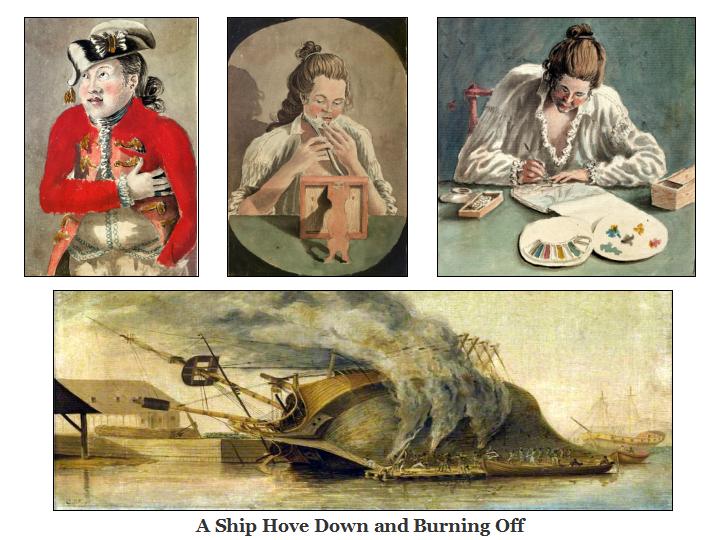 |
| Here are a few more of the paintings which can be seen on their website by Gabriel Bray, including him shaving and painting on board ship.
|
 |
After 1782 he was a Captain in the Customs House Service. Most of Bray's career was spent in the Revenue Service, defending the coast against smugglers.
He commanded “ The Hind ” from 1789 which was stationed in the Channel Between Portland and Lands End and gained himself a reputation for dealing ruthlessly with smugglers.
|
 |
| A few years earlier, while in command of the Revenue cutter, "Scourge" off the Kent coast, Bray had confronted a notorious smuggler named Brown in the act of landing spirits on the beach near Deal. the ensuing fight was graphically described in the Whitehall Evening Post: "Captain Bray boarded his ship, and though Brown presented a blunderbuss both of them not being half a distance from each other, the Captain was not daunted. One of his men seeing his brave master in this situation, with a cutlass cut Brown's cheek clean off. Bray with his cutlass nearly severed his head from his body. In 1790 he married and the family moved to Fowey, Cornwall.
|
 |
| He retired in 1809, moving to Charmouth, and becoming a local churchwarden. There he proposed a new lifeboat design in 1817 for which he was presented with a silver medal by the Royal Society. He died in 1823 and his wife continued to live in their house, which stood on the north side of the Street near the Church and it was put up for auction on her death in 1835.
|
 |
| In 1818 Gabriel Bray painted the new Gallery with a series representing Christ and his disciples. We are fortunate that we can still see how they once would have looked from the model of the old Church which reveals the interior on removal of its roof.
|
 |
To the right of the path that leads to the Church is the tomb of John Hodges, whose family were butchers for many years. He purchased Beech House, from Isaac Cooke in 1841 and opened a shop in part of it. He was to prosper and in time purchased a number of properties in the village including the Coast Guards Cottages in Lower Sea Lane and Sandford House. He also extended Beech House into what is now Walton House with its adjoining Butchers shop.
He married Jane Mansfield and they were to have 9 children. It is Richard, who is born in 1845, who inherits the business, on his fathers death. Another son, Charles goes on to leave £500, the interest of which was to be given to the poor of Charmouth. He also paid for the Brass Eagle Lectern in memory of his parents. But most important of all is the £1000 he left to buy the Playing Field, which has benefited the village ever since.
|
 |
The most dominant Tomb in the Churchyard is near the entrance and is that to Lieutenant James Warden. The inscription on all sides records his life achievements in glowing detail, but it is that on the front which is of most interest as it records that he fell in a Duel in 1792. He only lived briefly in the village but left his mark for evermore.
He inherited a considerable fortune from an Aunt on her death in 1788. She had been married to Captain William Parks and lived in Limehouse, London. With this money he was able to buy the Manor of Charmouth which included Langmoor when it was auctioned by Richard Henvill in the same year. He had previously been married to Elizabeth and had three children. She was to die in 1773 and six years later he wed Elizabeth Newell Puddicombe, who herself had been married to James Crowter. Her family came from Lyme Regis and a brother,the Reverend Thomas Puddicombe of Branscombe owned Wood Farm in Charmouth.
James Warden was very argumentative and even took the Village Curate, Brian Coombes to Court accusing him of stealing seaweed and pebbles from the Beach.
|
 |
| This climaxed with an altercation with a neighbouring landowner, Norman Bond. When Warden and Bond met in the street, an argument ensued in which Warden became extremely abusive and threatened to shoot Bond's dogs. Bond demanded Warden apologise, Warden refused, and so Bond challenged Warden to a duel. The time and place was quickly set, the duellers would meet at Hunters' Lodge Inn on the morning of 28 April 1792. James was shot through the heart and the neighbour fleeing the country to Barbados. His wife Elizabeth, was to survive him by 7 years, She was to lease Langmoor to a Mr Dicken and move to Axminster where she was to spend her last years. James had fallen out with his eldest son and on the death of Elizabeth in 1798, his estate went to his daughter, Ann Liddon.
|
 |
| Peter Clapcott was a Captain in the army and married Leah Goring in 1769 at St. Marys in Bridport. Her father, Peter Goring owned The Fountain Inn, which is now Charmouth House. The Clapcotts had a daughter, Mary who married Samuel Bartlett Jerrard of Chideock in 1792 at Stanton St. Gabriels Chapel. They were to inherit the Clapcotts House. It is fortunate that they still owned it in 1841, for the Tithe Map of that year identifies it as "Grange House" and the acre behind now has a number of houses built on it, including the "Old Fire Engine House". Another field is the site of Parkway, off Lower Sea Lane.
|
 |
| With its high surrounding hills, there were many accidents reported over the years in Charmouth.The Church has a Grave for one such casualty. For in 1805 Ann Pitt who was travelling from Exeter to London was thrown off the top of the Coach into the road and died immediately and was buried at St. Andrews. The Vestry Book records a similar story when George Morley was buried in 1791,after falling from the top of another Exeter Coach.
|
 |
| One of the earliest gravestones to have survived is that for William Edwards and his family. His detailed Will gives us valuable information about his family and where they lived. He described himself as a Common Carrier, with a wagon for delivering goods. His family owned the 3 Crowns, now the "Coach and Horses" opposite, which was a stop off for coaches and wagons from London to Exeter and would have supplied him with his trade. The Edwards lived in a large thatched building opposite the Inn. He left it to his daughter, who in turn left it to her daughter who was married to the son of Joseph Bradbeer, landlord of the 3 Crowns. |
 |
Joseph Bradbeer, had originally come from Blandford Forum and was for a number of years the Landlord of “ The Three Crowns ”. Tragedy struck the family in 1804 when Joseph lost his wife Mary, his daughter Maria Richards as well as her husband. The following year it was to be his son Francis, who was to mourn the loss of his wife, Elizabeth, who had inherited the building formerly owned by William Edwards.
Joseph Bradbeer rented part of this from his son and in 1806 opened a Post Office and Store there, which was to become Charmouth Stores, which still operates from the same site over 200 years later.
A Census for the village in 1812, describes Thomas Browning, who occupies the west part of the building as a “ Coach Man ” and Joseph Bradbeer, who is in the east part as a “ Post Master ”. On his death in 1821 at the age of 71 he left his estate to his wife, Lydia, who continues running the shop and letting the other part and its stables.
|
 |
| Lydia Bradbeer later rented part of the building to John Carter, who opened a shop there in 1832. After a disastrous second marriage to William Watts, she lost her properties, which were auctioned in 1841. The Tithe Map and Census for the same year, show her, now single, running a shop in what is now Charmouth Stores, with John Carter taking over as Post Master, in the central section of the building. This was a year after the Penny Post was introduced and a cover of that year with a Penny Black from Charmouth is shown here. Directories of the time advertise the business as that of a Grocers, Post Office and Builders. John and his wife Wilment had a son, John William, who was born in Charmouth in 1842. Sadly John was to die at an early age in 1855 and leaves the shop to his wife.A Fire that swept through the group of buildings in 1864 must have been a huge setback. But the following year,the houses were rebuilt as"Prospect Place"and John William Carter was back in business and advertising in the local directory as Grocer and Postmaster. He continues for awhile, but by 1870 George Mortimer is the owner.
|
 |
Jonas Wishcombe, rented Waterloo House, which is coincidentally a Fossil Shop today. He described himself as a Fossilist in the 1830 Pigot`s Directory, and works with many of the famous collectors of his day. In 1832 he assisted Thomas Hawkins, dig out one of largest Ichthyosaurus, which was sold for £210 to the Natural History Museum, where it can still be seen.
A newspaper advert for 1826 records that Jonas would sell his finds to travellers staying at The Coach and Horses in Charmouth.
|
 |
| 1832 was to be a tragic year for the Village as Cholera swept through the area from Bridport. James Welsh, aged 58, Francis Cole, aged 45 and Captain George Sidney Smith aged 40 were to die as a result. The latter's tomb still stands in the Church Yard as a reminder of this episode in Charmouth's history. He was nephew of Admiral Sir Sidney Smith and had been involved in a number of skirmishes during the Napoleonic wars. He spent several years in captivity at Verdun, where he learnt French, and was selected to command the boat in which Napoleon Bonaparte embarked when quitting France for Elba. George later commanded the "Bustard" Sloop in the West Indies and was promoted to Captain in 1828. Whilst living in Charmouth he would have been with a large number of fellow officers who chose to live here. But sadly his stay was to be cut short by Cholera.
|
 |
| Digory Gordge is a name to conjure with. It must have been popular as it went down through at least 5 generations in Charmouth. The first one in the register was the son of Ralph and Anna. His,son Digory was born in 1759. followed by his son Digory born in 1784. He married Martha Squire in 1806, and had a son Digory who died in 1831. There were five other children, one of whom had thirteen children. The Digory whose grave is referred to was Clerk of the parish for fifty six years. He started with a salary of three guineas a year. His other duties besides being clerk were constant 'attendants" and cleaning the church. His name appears as witness at most marriages and there are many of papers in the Vestry signed by him. After twenty six years he wrote to the churchwardens asking for an increase in his salary as the number of inhabitants had increased, this was raised to eight guineas a year. He lived in a thatched cottage at the corner of Barrs Lane, which was destroyed in a fire in 1895, where the Post Office stands today. A descendant continued to live there and complained of Poltergeists, which were investigated by Conan Doyle, the Author of Sherlock Holmes.
|
 |
Giles Pryer moved to Charmouth in 1827 and described himself as a Mason and Plasterer. By 1841 he had bought what is today Stanley House and was to buy the field known as Pear Close from the Reverend Hales and have his workshops there. With his wife, Elizabeth, they bought up seven children and in 1854 built the Cement Works, which is now the Heritage Centre, for George Morcome.
But in 1864 a fire started in the thatch of his house and spread all along the adjoining cottages. He rebuilt them afterwards and are now: Stanley House, Rupert House, Breeze and Nisa. On his death in 1881, his son Harry, known as Pussey, took over the business which continued to prosper until his death in 1931. His former workshops and field opposite were afterwards redeveloped as the shops we see today.
|
 |
Tobit Gear who was born in Misterton in 1794 and moved to Charmouth in the mid 19th century. He is shown in the 1861 Census as a Tinman (Peddler) then living in Old Lyme Road with his wife Elizabeth in a house which they bought from Digory Gordge. Their son Matthew Gear in the same year is described as a Fish Salesman who was born in Symondsbury in 1823. Matthew and his wife had a son - Matthew James Gear, born in 1868 who continues the family trade as a Fish Salesman.Their eldest son Cecil again continues the family business and in 1931 opens a shop in the Street near its junction with Old Lyme Road. But his life is tragically cut short in 1944 . It is his daughter, Sheila Stamp who is shown in the early photo outside his shop.
His brother, William Arthur Gear was born in 1898 and started an automobile business. This was originally in the stables of The George, but then moved to The Coach and Horses in 1923 and finally to Pear Close in the centre of the village.His business prospered and the Garage expanded on the site. He was Charmouth foremost businessman and owned the large Car Park by the beach and a number of properties.
|
 |
|
George Holly moved to the village in 1848, and remained landlord of the Mail Coach Inn for next 40 years and changed its name to "The Coach and Horses". The Inn was used extensively by commercial travellers during the coaching period. One of these gentlemen was accidentally drowned whilst bathing. Mr Holly paid for his funeral and 357 of his friends subscribed and gave Mr. Holly, a silver Coffee Pot as a mark of esteem in 1849. The advent of the railways marked an end to the coaches and the photo here from 1860 shows the Coronet Coach on its last journey. In 1873 George purchased Charmouth House, which stands at the corner of Higher Sea Lane for £1560 and was to live there and run it as an Hotel. In 1882 a devastating fire destroyed the old "Coach and Horses" and George never returned and was to die four years later and his daughter, Mrs Elizabeth Salisbury took over running his Hotel with her brother, George Holly Jnr. |
 |
| As soon as the name of Whittington comes up, we immediately associate it with the Pantomime, Dick Whittington. A descendant of the real life hero, who was to become Lord Mayor of London in the 14th Century, moved to the village in 1900 and lived with his family at "The Limes", now known as Charmouth Lodge. He also went by the name of Richard Whittington, and was formerly Rector of Orsett in Essex. He had 1 son and 5 daughters with his wife Julia. Their time was short in the village and he died in 1906 and his wife 5 years later.
|
 |
| None of the five daughters married and the longest surviving, Winnie and Joan, retained the position of Grande Dames of the village until Winnie died in 1974, aged 95, and Joan died in 1976, aged 91. They were well-known as a result of their pedigree and also through their involvement in church matters, the tennis club and an exclusive private school in the adjoining building to the Limes now known as Little Lodge, which had formerly been a shop. In 1953 the sisters installed a memorial prayer desk in St. Andrews and gave an Alms dish in memory of their father, Canon Whittington.
|

